A Practical Framework for Developing Net-Zero Electricity Mix Scenarios: A Case Study of South Korea
Abstract
1. Introduction
1.1. Review of the 2050 Carbon Neutrality Scenario and 2030 Nationally Determined Contribution (NDC) Enhancement Plans
1.2. Review of 9th Basic Plan for Long-Term Electricity Supply and Demand (BPE)
1.3. Proposal
- A framework that continuously reflects the changes in EM-related energy plans must be established.
- Domestic characteristics regarding the supply of each energy source must be considered.
- Management of the scale of system inertia and fuel-conversion levels is necessary.
2. Overview of the Proposed Practical Net-Zero Electricity Mix Scenario (NEMS) Framework for South Korea
3. Step 1: Total Electricity Consumption and Demand Pattern Forecast
3.1. Forecast of the Total Electricity Consumption for South Korea
3.2. Demand Pattern Forecast Algorithm (DPFA)
4. Step 2: Forecasting the Generation and Capacity of New and Renewable Energies (NRE)
4.1. Total New and Renewable Energies (NRE) Generation Forecast
4.2. Generation Forecasts by New and Renewable Energy (NRE) Type
4.2.1. Renewable Energy: Hydro, PV, and Wind
4.2.2. Renewable Energy: Conventional Hydropower, Marine Energy, and Bioenergy
4.2.3. New Energy: Fuel Cells, Integrated Gasification Combined Cycle (IGCC), and Ammonia and Hydrogen Turbines
4.3. Generation Forecasts by New and Renewable Energy (NRE) Type and Region
4.4. Capacity Forecasts by New and Renewable Energy (NRE) Type and Region
5. Step 3: Generation Forecasts of Resources Subject to Fuel Conversion and Nuclear Power
5.1. Forecasts of Generation and Capacity of Resources Subject to Fuel Conversion and Nuclear Power for 2030 and 2050
5.2. Net-Zero Electricity Mix Scenario (NEMS) Results
5.3. Evaluation of Net-Zero Electricity Mix Scenario (NEMS) Characteristics
5.3.1. System Inertia Resource Ratio (SIRR)
5.3.2. Fuel Conversion Rate (FCR)
6. Conclusions
Author Contributions
Funding
Data Availability Statement
Conflicts of Interest
Appendix A. Commissioning and Decommissioning Dates and Capacities of Coal, LNG, and Nuclear Power Generators
| Resource Name | Commissioning Date | Decommissioning Date | Capacity (MW) |
|---|---|---|---|
| Pyeongtaek #1 | 1 April 1980 | 1 December 2024 | 350 |
| Pyeongtaek #2 | 30 June 1980 | 1 December 2024 | 350 |
| Pyeongtaek #3 | 4 May 1983 | 1 December 2024 | 350 |
| Pyeongtaek #4 | 1 August 1983 | 1 December 2024 | 350 |
| Mokdong CHP #1 | 31 December 1987 | 16 December 2047 | 21 |
| Seoincheon 1CC#1 | 17 November 1992 | 1 December 2028 | 225 |
| Seoincheon 1CC#2 | 17 November 1992 | 1 December 2028 | 225 |
| Seoincheon 1CC#3 | 17 November 1992 | 1 December 2028 | 225 |
| Seoincheon 1CC#4 | 17 November 1992 | 1 December 2028 | 225 |
| Seoincheon 1CC#5 | 17 November 1992 | 1 December 2028 | 225 |
| Seoincheon 1CC#6 | 17 November 1992 | 1 December 2028 | 225 |
| Seoincheon 1CC#7 | 17 November 1992 | 1 December 2028 | 225 |
| Seoincheon 1CC#8 | 17 November 1992 | 1 December 2028 | 225 |
| Bucheon CC#1 | 1 February 1993 | 1 May 2028 | 450 |
| Bundang CC #1 | 16 September 1993 | 1 September 2053 | 560 |
| Ilsan CC#1 | 1 December 1993 | 16 November 2053 | 600 |
| Ulsan CC#1 | 1 June 1995 | 17 May 2055 | 300 |
| Ilsan CC#2 | 31 March 1996 | 16 March 2056 | 300 |
| Bundang CC #2 | 31 March 1997 | 16 March 2057 | 340 |
| Incheon CC#1 | 1 July 1997 | 16 June 2057 | 450 |
| Incheon CC#2 | 1 July 1997 | 16 June 2057 | 450 |
| Incheon CC#3 | 1 July 1997 | 16 June 2057 | 450 |
| Incheon CC#4 | 1 July 1997 | 16 June 2057 | 450 |
| Ulsan CC#2 | 1 August 1997 | 17 July 2057 | 450 |
| Ulsan CC#3 | 1 August 1997 | 17 July 2057 | 450 |
| Anyang CC#1 | 1 December 2000 | 1 December 2021 | 450 |
| POSCO Energy CC#3 | 16 March 2001 | 1 March 2061 | 450 |
| POSCO Energy CC#4 | 16 March 2001 | 1 March 2061 | 450 |
| GS Dangjin CC#1 | 1 April 2001 | 17 March 2061 | 501 |
| Ansan Urban Development CHP | 1 June 2001 | 17 May 2061 | 61 |
| Boryeong CC#1 | 1 August 2002 | 17 July 2062 | 450 |
| Boryeong CC#2 | 1 August 2002 | 17 July 2062 | 450 |
| Boryeong CC#3 | 1 August 2002 | 17 July 2062 | 450 |
| Busan CC#1 | 1 March 2004 | 15 February 2064 | 450 |
| Busan CC#2 | 1 March 2004 | 15 February 2064 | 450 |
| Busan CC#3 | 1 March 2004 | 15 February 2064 | 450 |
| Busan CC#4 | 1 March 2004 | 15 February 2064 | 450 |
| Incheon 1CC | 1 June 2005 | 17 May 2065 | 504 |
| Yulchon CC#1 | 5 September 2005 | 21 August 2065 | 526 |
| GS Dangjin 2CC | 1 November 2005 | 17 October 2065 | 500.25 |
| Gwangyang 1CC | 13 February 2006 | 29 January 2066 | 495 |
| Gwangyang 2CC | 15 May 2006 | 30 April 2066 | 495 |
| Hwaseong CHP 1CC | 30 November 2007 | 15 November 2067 | 588.3 |
| Incheon 2CC | 1 June 2009 | 17 May 2069 | 508.9 |
| Songdo CHP 1CC | 30 April 2010 | 15 April 2070 | 219.55 |
| Incheon Airport 1CC | 19 May 2010 | 4 May 2070 | 127 |
| Gunsan 1CC | 31 May 2010 | 16 May 2070 | 718.4 |
| Paju CHP 1CC | 23 August 2010 | 8 August 2070 | 515.5 |
| Yeongwol 1CC | 31 October 2010 | 16 October 2070 | 848 |
| Pangyo CHP 1CC | 30 November 2010 | 15 November 2070 | 146.314 |
| Daejeon Southwest CHP | 31 January 2011 | 16 January 2071 | 48.3 |
| POSCO Energy CC#5 | 28 February 2011 | 13 February 2071 | 574.5 |
| POSCO Energy CC#6 | 30 June 2011 | 15 June 2071 | 574.58 |
| Gwanggyo Heat & Power CC | 1 November 2012 | 17 October 2072 | 144.8 |
| Incheon 3CC | 1 December 2012 | 16 November 2072 | 450 |
| Oseong CC#1 | 1 March 2013 | 14 February 2073 | 800 |
| Suwan CHP CC | 1 April 2013 | 17 March 2073 | 115.24 |
| Byeolnae Heat CC | 1 July 2013 | 16 June 2073 | 130.4 |
| GS Dangjin CC#3 | 1 July 2013 | 16 June 2073 | 382 |
| Sejong CHP | 1 November 2013 | 17 October 2073 | 530 |
| Andong CC | 2 April 2014 | 18 March 2074 | 400 |
| Yangju CHP CC | 9 April 2014 | 25 March 2074 | 555.1 |
| Yulchon CC#2 | 29 April 2014 | 14 April 2074 | 885 |
| Pocheon CC#1 | 1 July 2014 | 16 June 2074 | 725 |
| Daegu Green Power CC | 1 July 2014 | 16 June 2074 | 415.15 |
| Ulsan CC#4 | 29 July 2014 | 14 July 2074 | 871.9 |
| POSCO Energy CC#7 | 30 July 2014 | 15 July 2074 | 382.4 |
| Pocheon CC#2 | 9 August 2014 | 25 July 2074 | 725 |
| Pyeongtaek CC#2 | 29 September 2014 | 14 September 2074 | 868.5 |
| POSCO Energy CC#8 | 21 October 2014 | 6 October 2074 | 382 |
| Asan Bae CHP CC | 21 October 2014 | 6 October 2074 | 101.7 |
| Ansan CC | 7 November 2014 | 23 October 2074 | 751.2 |
| POSCO Energy CC#9 | 1 January 2015 | 17 December 2074 | 383 |
| Dongducheon 2CC | 1 January 2015 | 17 December 2074 | 858 |
| Dongducheon 1CC | 1 March 2015 | 14 February 2075 | 858 |
| Hanam CHP CC | 1 October 2015 | 16 September 2075 | 399 |
| Luxury Osan CHP 1CC | 1 March 2016 | 15 February 2076 | 436.1 |
| Paju 1CC | 1 February 2017 | 17 January 2077 | 848 |
| Pocheon Natural CC | 17 March 2017 | 2 March 2077 | 874.2 |
| Paju 2CC | 28 March 2017 | 13 March 2077 | 848 |
| GS Dangjin CC#4 | 15 April 2017 | 31 March 2077 | 846 |
| Wirye New Town | 15 April 2017 | 31 March 2077 | 413 |
| Chuncheon CHP CC | 1 May 2017 | 16 April 2077 | 470 |
| Yeongnam Power 1CC | 1 November 2017 | 17 October 2077 | 476.1 |
| Dongtan CHP 1CC | 23 November 2017 | 8 November 2077 | 378.4 |
| Dongtan CHP 2CC | 4 December 2017 | 19 November 2077 | 378.4 |
| Busan Jeonggwan Energy CC | 1 January 2018 | 17 December 2077 | 50.2 |
| Anyang CHP 2-1CC | 1 August 2018 | 17 July 2078 | 481 |
| Seoul CC#2 | 1 July 2019 | 16 June 2079 | 400 |
| Shinpyeongtaek CC#1 | 1 November 2019 | 17 October 2079 | 863.3 |
| Seoul CC#1 | 11 November 2019 | 27 October 2079 | 400 |
| Jeju CC#1 | 18 December 2019 | 3 December 2079 | 125 |
| Jeju CC#2 | 14 January 2020 | 30 December 2079 | 125 |
| Anyang CHP 2-2CC | 1 December 2021 | 16 November 2081 | 467.5 |
| Yeoju CC#1 | 1 December 2022 | 16 November 2082 | 1000 |
| Yangsan collective energy | 1 April 2023 | 17 March 2083 | 118.9 |
| Daejeon CHP (9th) | 1 October 2023 | 16 September 2083 | 25 |
| Sejong Happiness CHP | 1 November 2023 | 17 October 2083 | 585 |
| Magok CHP | 1 November 2023 | 17 October 2083 | 285 |
| Yeosu Green Energy | 1 February 2024 | 17 January 2084 | 250 |
| Samcheonpo #3 LNG CC | 1 December 2024 | 16 November 2084 | 560 |
| Samcheonpo #4 LNG CC | 1 December 2024 | 16 November 2084 | 560 |
| Tongyeong CC#1 | 1 December 2024 | 16 November 2084 | 920 |
| Ulsan GPS CC | 1 December 2024 | 16 November 2084 | 1122 |
| Eumseong Green Energy CC | 1 December 2024 | 16 November 2084 | 1122 |
| Daegu CHP #1 | 1 December 2024 | 16 November 2084 | 261 |
| Cheongju CHP #1 | 1 December 2024 | 16 November 2084 | 261 |
| Bucheon CHP #2-1 | 1 May 2025 | 16 April 2085 | 498 |
| Taean #1 LNG CC | 1 December 2025 | 16 November 2085 | 500 |
| Taean #2 LNG CC | 1 December 2025 | 16 November 2085 | 500 |
| Boryeong #5 1CC | 1 December 2025 | 16 November 2085 | 500 |
| Boryeong #6 1CC | 1 December 2025 | 16 November 2085 | 500 |
| Hadong #1 CC | 1 June 2026 | 17 May 2086 | 500 |
| Hadong #2 CC | 1 June 2027 | 17 May 2087 | 500 |
| Samcheonpo #5 CC | 1 July 2027 | 16 June 2087 | 500 |
| Samcheonpo #6 CC | 1 January 2028 | 17 December 2087 | 500 |
| Bucheon CHP #2-2 | 1 May 2028 | 16 April 2088 | 498 |
| Hadong #3 CC | 1 June 2028 | 17 May 2088 | 500 |
| Hadong #4 CC | 1 December 2028 | 16 November 2088 | 500 |
| Taean #3 CC | 1 December 2028 | 16 November 2088 | 500 |
| Dangjin #1_2 CC | 1 December 2029 | 16 November 2089 | 1000 |
| New LNG #1CC (9th) | 1 December 2029 | 16 November 2089 | 500 |
| New LNG #2CC (9th) | 1 December 2029 | 16 November 2089 | 500 |
| Taean #4 CC | 1 December 2029 | 16 November 2089 | 500 |
| Dangjin #3_4 CC | 1 September 2030 | 17 August 2090 | 1000 |
| Hadong #5 CC | 1 June 2031 | 17 May 2091 | 500 |
| Hadong #6 CC | 1 December 2031 | 16 November 2091 | 500 |
| Taean #5 CC | 1 December 2032 | 16 November 2092 | 500 |
| Taean #6 CC | 1 December 2032 | 16 November 2092 | 500 |
| Yeongheung #1 CC | 1 June 2034 | 17 May 2094 | 800 |
| Yeongheung #2 CC | 1 December 2034 | 16 November 2094 | 800 |
| Total capacity (MW) | 41,448.7 | ||
| Resource Name | Commissioning Date | Decommissioning Date | Capacity (MW) |
|---|---|---|---|
| Honam #1 | 1 October 1972 | 16 September 2032 | 250 |
| Honam #2 | 1 October 1972 | 16 September 2032 | 250 |
| Samcheonpo #1 | 1 August 1983 | 17 July 2043 | 560 |
| Boryeong #1 | 1 December 1983 | 16 November 2043 | 500 |
| Samcheonpo #2 | 1 February 1984 | 17 January 2044 | 560 |
| Boryeong #2 | 1 September 1984 | 17 August 2044 | 500 |
| Samcheonpo #3 | 1 April 1993 | 17 March 2053 | 560 |
| Boryeong #3 | 1 June 1993 | 17 May 2053 | 500 |
| Boryeong #4 | 1 June 1993 | 17 May 2053 | 500 |
| Samcheonpo #4 | 1 March 1994 | 14 February 2054 | 560 |
| Boryeong #5 | 1 September 1994 | 17 August 2054 | 500 |
| Boryeong #6 | 1 September 1994 | 17 August 2054 | 500 |
| Taean #1 | 1 June 1995 | 17 May 2055 | 500 |
| Taean #2 | 1 December 1995 | 16 November 2055 | 500 |
| Taean #3 | 1 March 1997 | 14 February 2057 | 500 |
| Samcheonpo #5 | 1 June 1997 | 17 May 2057 | 500 |
| Taean #4 | 1 September 1997 | 17 August 2057 | 500 |
| Samcheonpo #6 | 1 January 1998 | 17 December 2057 | 500 |
| Dangjin #1 | 30 June 1999 | 15 June 2059 | 500 |
| Yeosu #2 | 1 November 1999 | 17 October 2059 | 328.6 |
| Hadong #1 | 1 November 1999 | 17 October 2059 | 500 |
| Hadong #2 | 1 November 1999 | 17 October 2059 | 500 |
| Hadong #3 | 1 November 1999 | 17 October 2059 | 500 |
| Hadong #4 | 1 November 1999 | 17 October 2059 | 500 |
| Dangjin #2 | 31 December 1999 | 16 December 2059 | 500 |
| Hadong #5 | 30 September 2000 | 15 September 2060 | 500 |
| Hadong #6 | 30 September 2000 | 15 September 2060 | 500 |
| Dangjin #3 | 31 December 2000 | 16 December 2060 | 500 |
| Dangjin #4 | 31 December 2000 | 16 December 2060 | 500 |
| Taean #5 | 28 May 2002 | 13 May 2062 | 500 |
| Taean #6 | 28 May 2002 | 13 May 2062 | 500 |
| Yeongheung #1 | 12 July 2004 | 27 June 2064 | 800 |
| Yeongheung #2 | 30 November 2004 | 15 November 2064 | 800 |
| Dangjin #5 | 30 September 2005 | 15 September 2065 | 500 |
| Dangjin #6 | 1 April 2006 | 17 March 2066 | 500 |
| Taean#7 | 28 February 2007 | 13 February 2067 | 500 |
| Dangjin #7 | 30 April 2007 | 15 April 2067 | 500 |
| Taean#8 | 31 July 2007 | 16 July 2067 | 500 |
| Dangjin #8 | 30 September 2007 | 15 September 2067 | 500 |
| Yeongheung #3 | 1 June 2008 | 17 May 2068 | 870 |
| Boryeong #7 | 19 June 2008 | 4 June 2068 | 500 |
| Boryeong #8 | 11 December 2008 | 26 November 2068 | 500 |
| Yeongheung #4 | 15 December 2008 | 30 November 2068 | 870 |
| Hadong #7 | 31 December 2008 | 16 December 2068 | 500 |
| Hadong #8 | 28 May 2009 | 13 May 2069 | 500 |
| Yeongheung #5 | 11 June 2014 | 27 May 2074 | 870 |
| Yeongheung #6 | 5 November 2014 | 21 October 2074 | 870 |
| Dangjin #9 | 1 December 2015 | 16 November 2075 | 1020 |
| Samcheok Green #1 | 1 June 2016 | 17 May 2076 | 1022 |
| Bukpyeong #1 | 1 June 2016 | 17 May 2076 | 595 |
| Dangjin #10 | 1 June 2016 | 17 May 2076 | 1020 |
| Taean #9 | 1 June 2016 | 17 May 2076 | 1050 |
| Yeosu #1 | 1 August 2016 | 17 July 2076 | 340 |
| Taean#10 | 1 May 2017 | 16 April 2077 | 1050 |
| Samcheok Green #2 | 1 June 2017 | 17 May 2077 | 1022 |
| Shinboryeong #1 | 30 June 2017 | 15 June 2077 | 1019 |
| Bukpyeong #2 | 1 August 2017 | 17 July 2077 | 595 |
| Shinboryeong #2 | 30 September 2017 | 15 September 2077 | 1019 |
| Shin Seocheon #1 | 1 March 2021 | 14 February 2081 | 1000 |
| Goseong High #1 | 1 April 2021 | 17 March 2081 | 1040 |
| Goseong High #2 | 1 October 2021 | 16 September 2081 | 1040 |
| Gangneung Anin #1 | 1 September 2022 | 17 August 2082 | 1040 |
| Gangneung Anin #2 | 1 March 2023 | 14 February 2083 | 1040 |
| Samcheok #1 | 1 October 2023 | 16 September 2083 | 1050 |
| Samcheok #2 | 1 April 2024 | 17 March 2084 | 1050 |
| Total capacity (MW) | 42,160.6 | ||
| Resource Name | Commissioning Date | Decommissioning Date | Capacity (MW) |
|---|---|---|---|
| Gori #2 | 25 July 1983 | 11 October 1901 | 650 |
| Gori #3 | 30 September 1985 | 7 August 1902 | 950 |
| Gori #4 | 29 April 1986 | 7 August 1902 | 950 |
| Hanbit #1 | 25 August 1986 | 7 August 1902 | 950 |
| Hanbit #2 | 10 June 1987 | 7 August 1902 | 950 |
| Hanul #1 | 1 September 1988 | 7 August 1902 | 950 |
| Hanul #2 | 1 September 1989 | 7 August 1902 | 950 |
| Hanbit #3 | 31 March 1995 | 26 September 1902 | 1000 |
| Hanbit #4 | 1 January 1996 | 26 September 1902 | 1000 |
| Wolseong #2 | 1 July 1997 | 30 November 1901 | 700 |
| Wolseong #3 | 1 July 1998 | 30 November 1901 | 700 |
| Hanul #3 | 1 August 1998 | 26 September 1902 | 1000 |
| Wolseong #4 | 1 October 1999 | 30 November 1901 | 700 |
| Hanul #4 | 31 December 1999 | 26 September 1902 | 1000 |
| Hanbit #5 | 21 May 2002 | 26 September 1902 | 1000 |
| Hanbit #6 | 23 December 2002 | 26 September 1902 | 1000 |
| Hanul #5 | 1 July 2004 | 26 September 1902 | 1000 |
| Hanul #6 | 1 April 2005 | 26 September 1902 | 1000 |
| Shin-Gori #1 | 1 February 2011 | 18 November 1902 | 1053 |
| Shinwolseong #1 | 1 July 2012 | 26 September 1902 | 1000 |
| Shin-Gori #2 | 20 July 2012 | 18 November 1902 | 1053 |
| Shinwolseong #2 | 24 July 2015 | 26 September 1902 | 1000 |
| Shin-Gori #3 | 1 April 2016 | 31 October 1903 | 1400 |
| Shin-Gori #4 | 1 September 2018 | 31 October 1903 | 1400 |
| Shin Hanul #1 | 1 July 2021 | 31 October 1903 | 1400 |
| Shin Hanul #2 | 1 May 2022 | 31 October 1903 | 1400 |
| Shin-Gori #5 | 1 March 2023 | 31 October 1903 | 1400 |
| Shin-Gori #6 | 1 June 2024 | 31 October 1903 | 1400 |
| Total capacity (MW) | 28,956 | ||
References
- The Ministry of Trade, Industry and Energy. The 9th Basic Plan on Electricity Demand and Supply; MOTIE: Sejong, Republic of Korea, 2020. Available online: http://a.to/23WWwz1 (accessed on 20 December 2023).
- Ministry Concerned. 2030 National Greenhouse Gas Reduction Target (NDC) Upgrade Plan: Sejong, Korea, 2021. Available online: http://a.to/23R7xGD (accessed on 20 December 2023).
- Ministry Concerned. 2050 Carbon Neutral Scenario Roadmap: Sejong, Korea, 2021. Available online: http://a.to/23e2AkC (accessed on 20 December 2023).
- Bouckaert, S.; Pales, A.F.; McGlade, C.; Remme, U.; Wanner, B.; Varro, L.; D’Ambrosio, D.; Spencer, T. Net Zero by 2050: A Roadmap for the Global Energy Sector. 2021. Available online: https://iea.blob.core.windows.net/assets/4719e321-6d3d-41a2-bd6b-461ad2f850a8/NetZeroby2050-ARoadmapfortheGlobalEnergySector.pdf (accessed on 20 December 2023).
- The Ministry of Trade, Industry and Energy. Commercialization of Ammonia Power Generation by 2030 and Hydrogen Power Generation by 2035. Available online: https://www.korea.kr/news/policyBriefingView.do?newsId=148895640 (accessed on 20 December 2023).
- Denis, G.; Prevost, T.; Debry, M.S.; Xavier, F.; Guillaud, X.; Menze, A. The Migrate project: The challenges of operating a transmission grid with only inverter-based generation. A grid-forming control improvement with transient current-limiting control. IET Renew. Power Gen. 2018, 12, 523–529. [Google Scholar] [CrossRef]
- Logan, K.G.; Nelson, J.D.; Hastings, A. Low emission vehicle integration: Will national grid electricity generation mix meet UK net zero? Proc. Inst. Mech. Eng. Part A J. Power Energy 2022, 236, 159–175. [Google Scholar] [CrossRef]
- Pina, A.; Silva, C.A.; Ferrão, P. High-resolution modeling framework for planning electricity systems with high penetration of renewables. Appl. Energy 2013, 112, 215–223. [Google Scholar] [CrossRef]
- Gaete-Morales, C.; Gallego-Schmid, A.; Stamford, L.; Azapagic, A. A novel framework for development and optimisation of future electricity scenarios with high penetration of renewables and storage. Appl. Energy 2019, 250, 1657–1672. [Google Scholar] [CrossRef]
- Aryanpur, V.; Atabaki, M.S.; Marzband, M.; Siano, P.; Ghayoumi, K. An overview of energy planning in Iran and transition pathways towards sustainable electricity supply sector. Renew. Sustain. Energy Rev. 2019, 112, 58–74. [Google Scholar] [CrossRef]
- Brand, B.; Missaoui, R. Multi-criteria analysis of electricity generation mix scenarios in Tunisia. Renew. Sustain. Energy Rev. 2014, 39, 251–261. [Google Scholar] [CrossRef]
- Elliston, B.; MacGill, I.; Diesendorf, M. Comparing least cost scenarios for 100% renewable electricity with low emission fossil fuel scenarios in the Australian National Electricity Market. Renew. Energy 2014, 66, 196–204. [Google Scholar] [CrossRef]
- Lund, P.D.; Skytte, K.; Bolwig, S.; Bolkesjö, T.F.; Bergaentzlé, C.; Gunkel, P.A.; Kirkerud, J.G.; Klitkou, A.; Koduvere, H.; Gravelsins, A.; et al. Pathway analysis of a zero-emission transition in the Nordic-Baltic region. Energies 2019, 12, 3337. [Google Scholar] [CrossRef]
- Choi, D.; Ahn, Y.-H.; Choi, D.G. Multi-criteria decision analysis of electricity sector transition policy in Korea. Energy Strategy Rev. 2020, 29, 100485. [Google Scholar] [CrossRef]
- Jeong, W.-C.; Lee, D.-H.; Roh, J.H.; Park, J.-B. Scenario analysis of the GHG emissions in the electricity sector through 2030 in South Korea considering updated NDC. Energies 2022, 15, 3310. [Google Scholar] [CrossRef]
- Min, D.; Ryu, J.-h.; Choi, D.G. Effects of the move towards renewables on the power system reliability and flexibility in South Korea. Energy Rep. 2020, 6, 406–417. [Google Scholar] [CrossRef]
- Korea Electric Power Corporation, Statistics of Electric Power in Korea 2020 (No.90). 2021. Available online: http://a.to/239AML0 (accessed on 20 December 2023).
- Korea Power Exchange. Available online: http://a.to/24ExlXi (accessed on 31 January 2023).
- Lee, J. Ocean Energy Development Status and Future Tasks. Bull. KSNRE 2021, 1, 2. [Google Scholar]
- The Ministry of Trade, Industry and Energy. New & Renewable Energy White Paper; MOTIE: Sejong, Republic of Korea, 2020. Available online: http://a.to/23s6sEQ (accessed on 20 December 2023).
- Lee, H.; Woo, Y.; Lee, M.-J. The need for R&D of ammonia combustion technology for carbon neutrality—Part II R&D trends and technical feasibility analysis. J. Korean Soc. Combust. 2021, 26, 84–106. [Google Scholar] [CrossRef]
- Korea Power Exchange. Power Generation Facility Status: Increase/Decrease Trend of Pumped Storage and Hydroelectric Power Plants. National Statistics Portal. Available online: http://a.to/23U7bda (accessed on 20 December 2023).
- Master’s Space. M-Core User’s Manual; MS: Anyang, Republic of Korea, 2016. [Google Scholar]

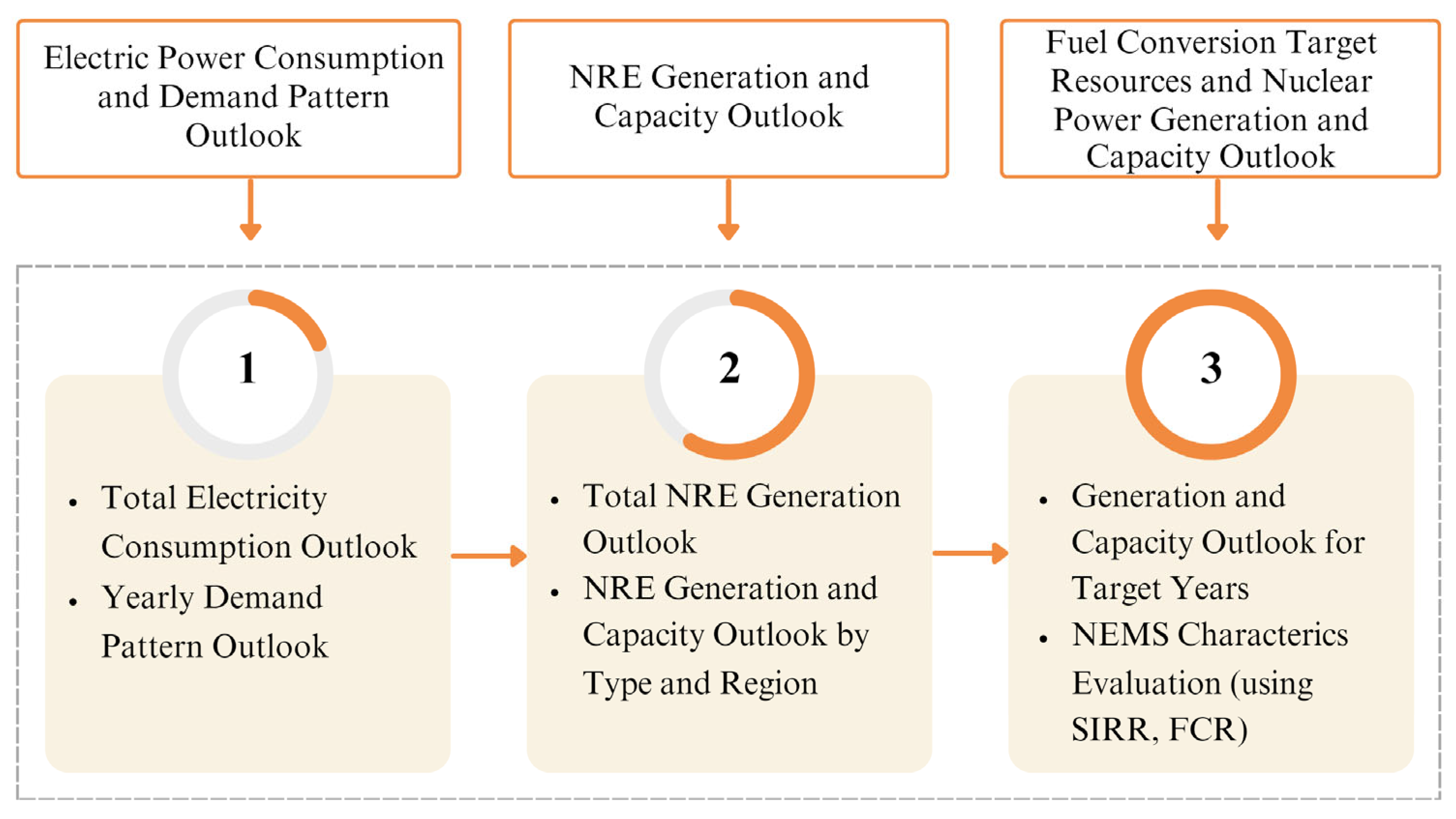

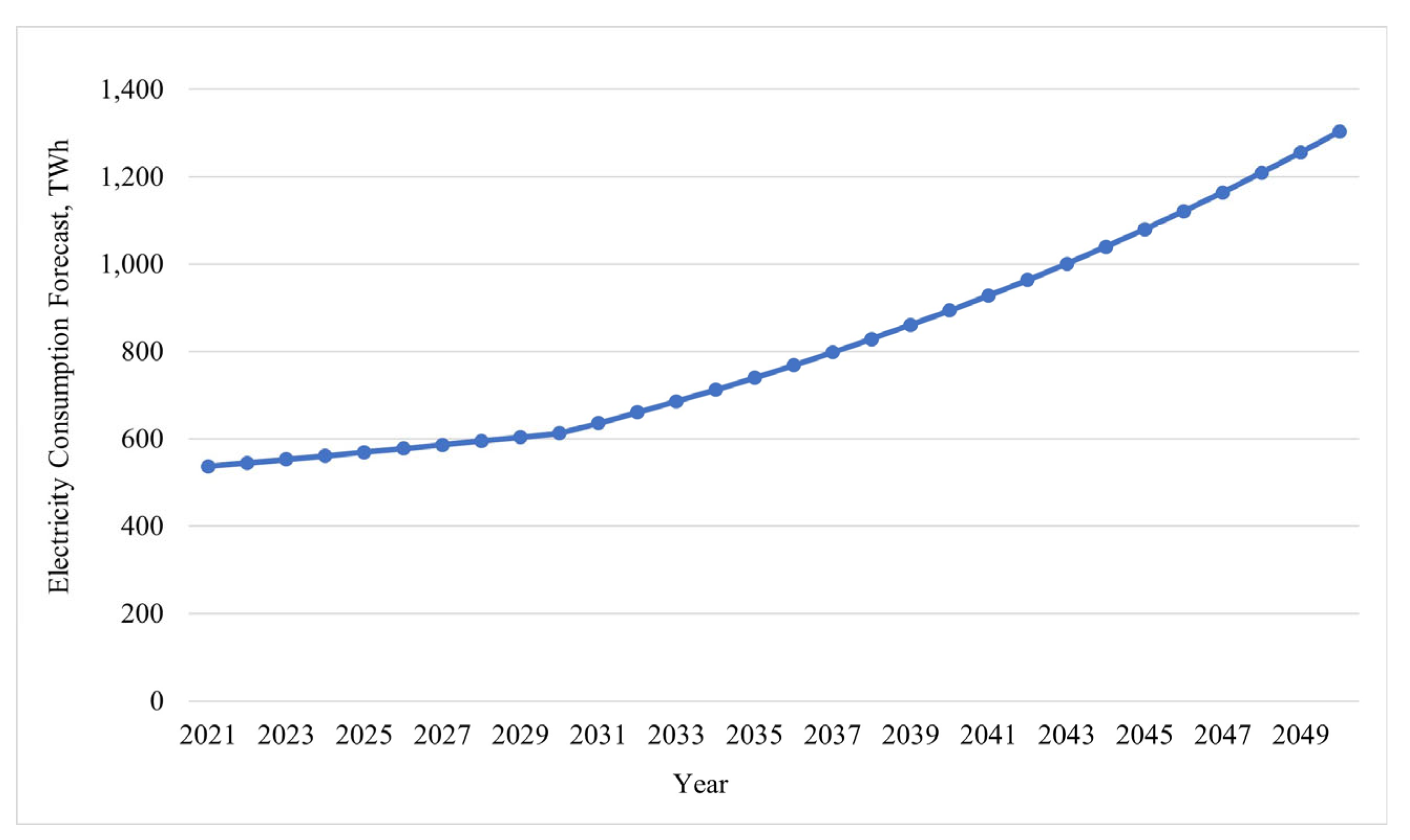

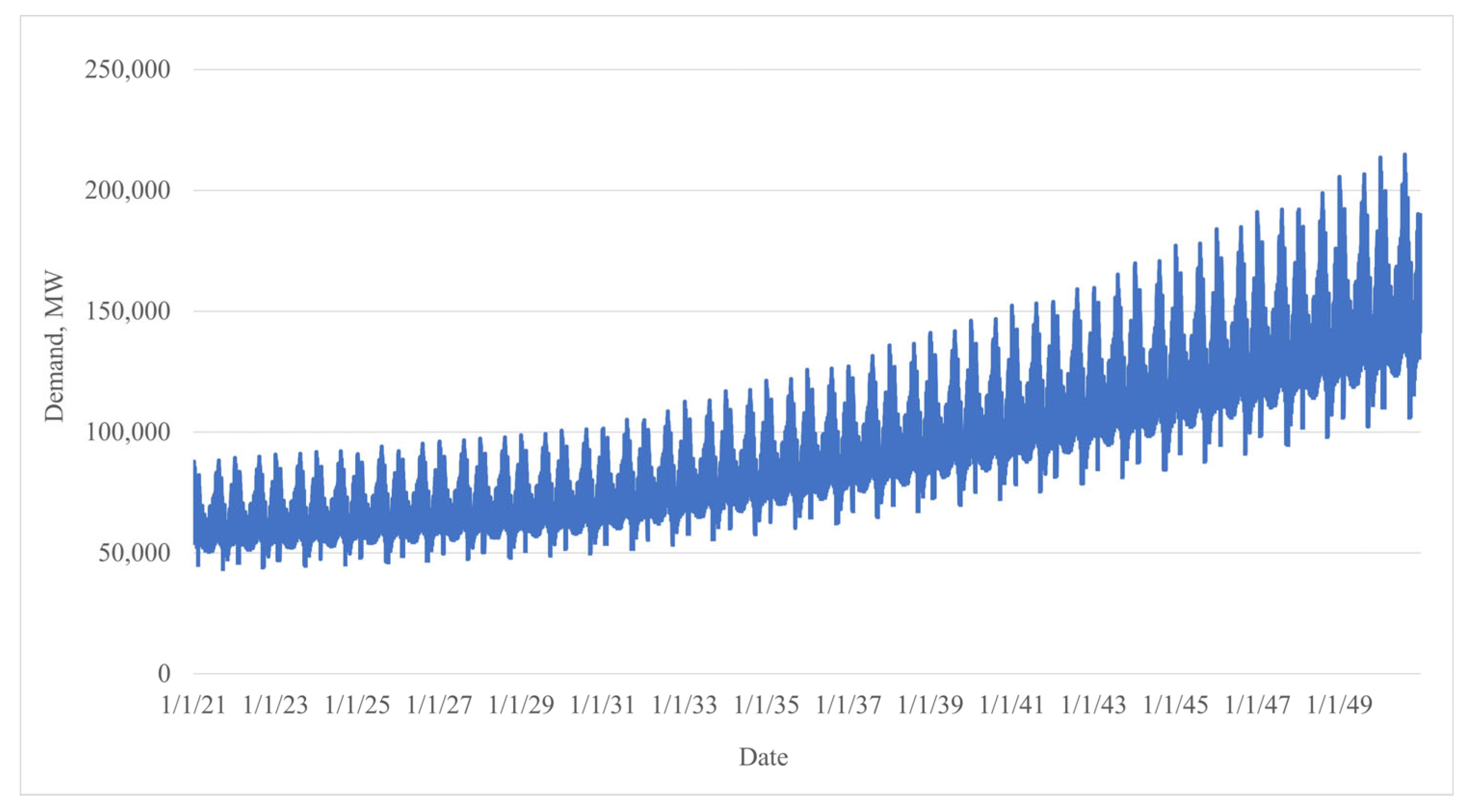

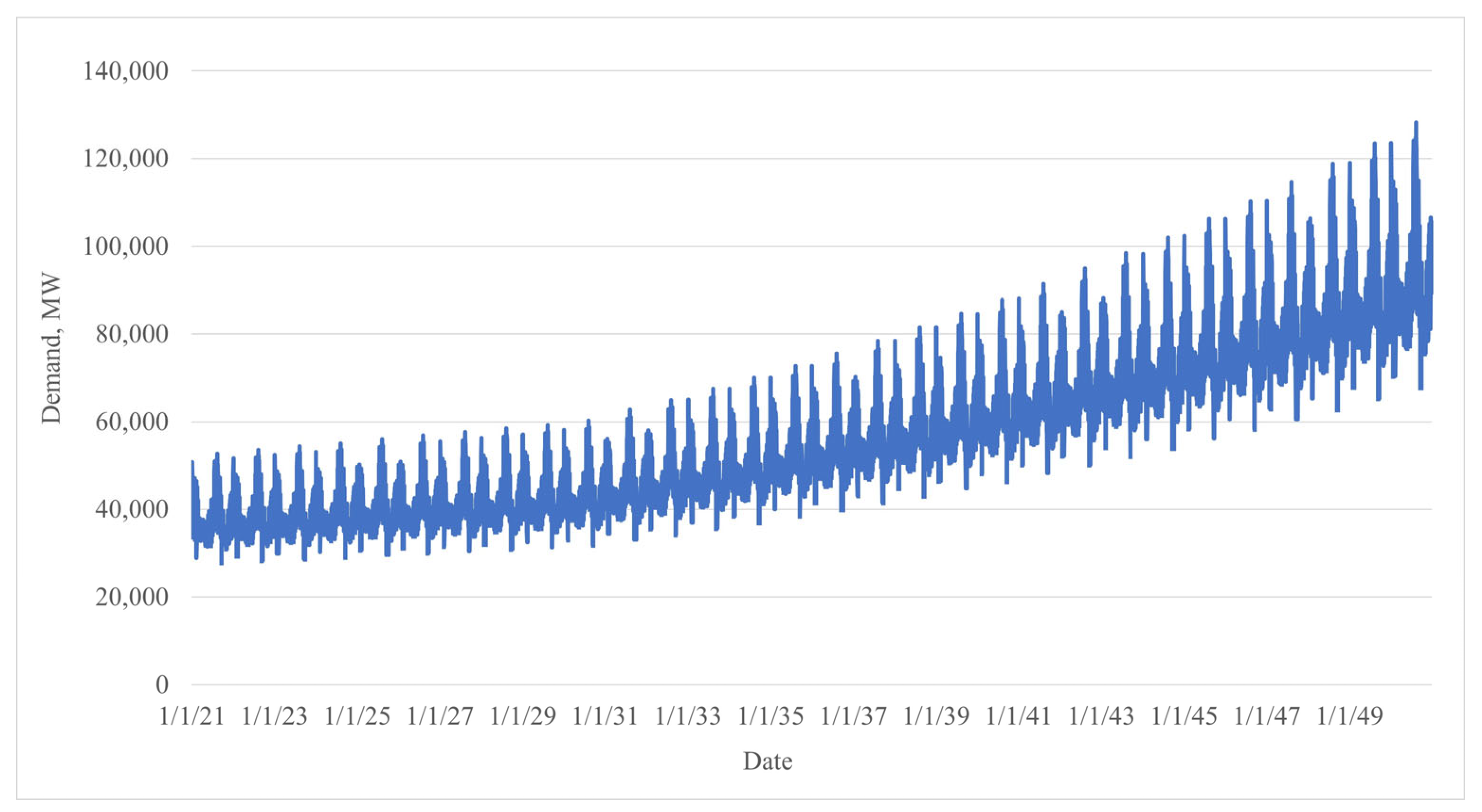
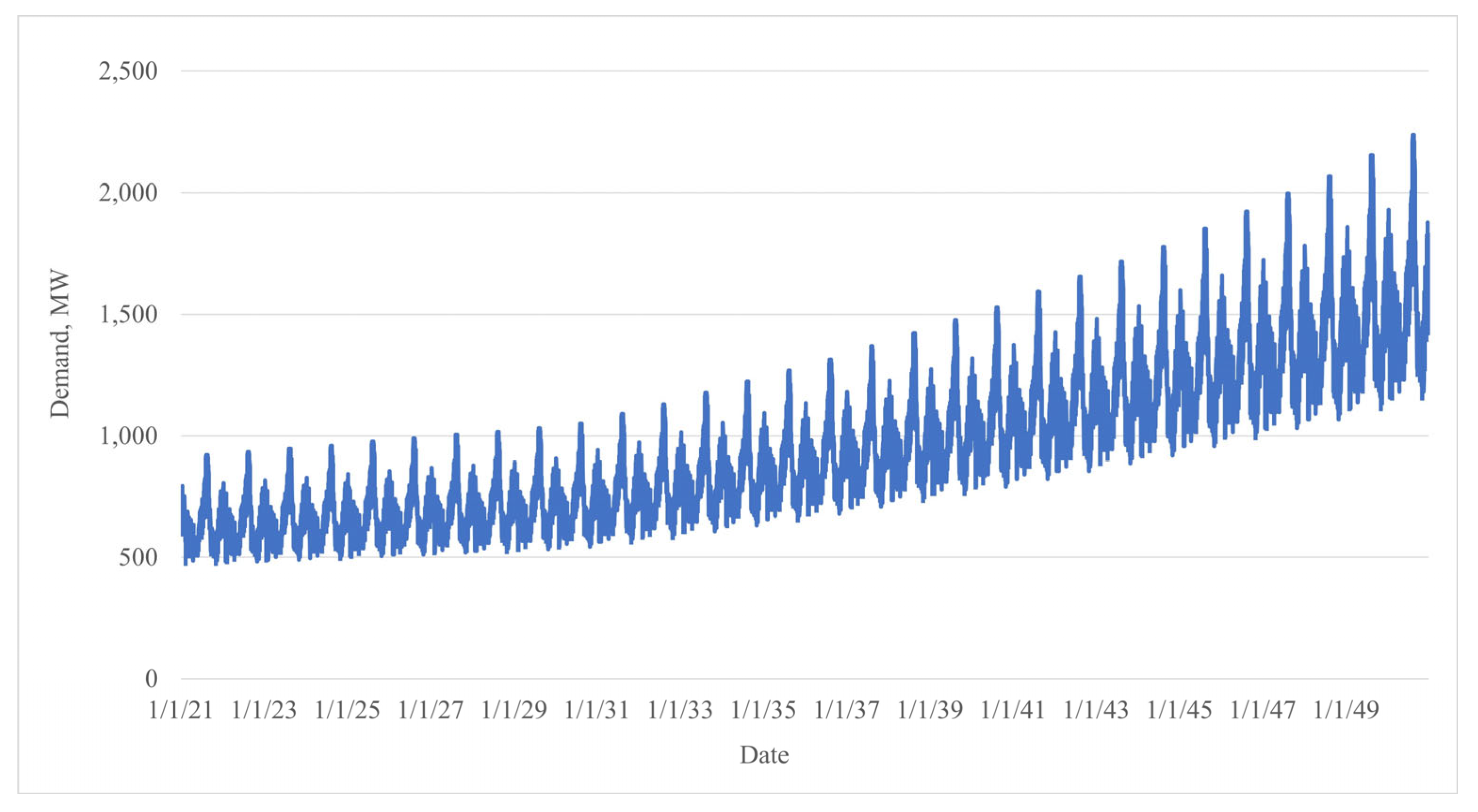

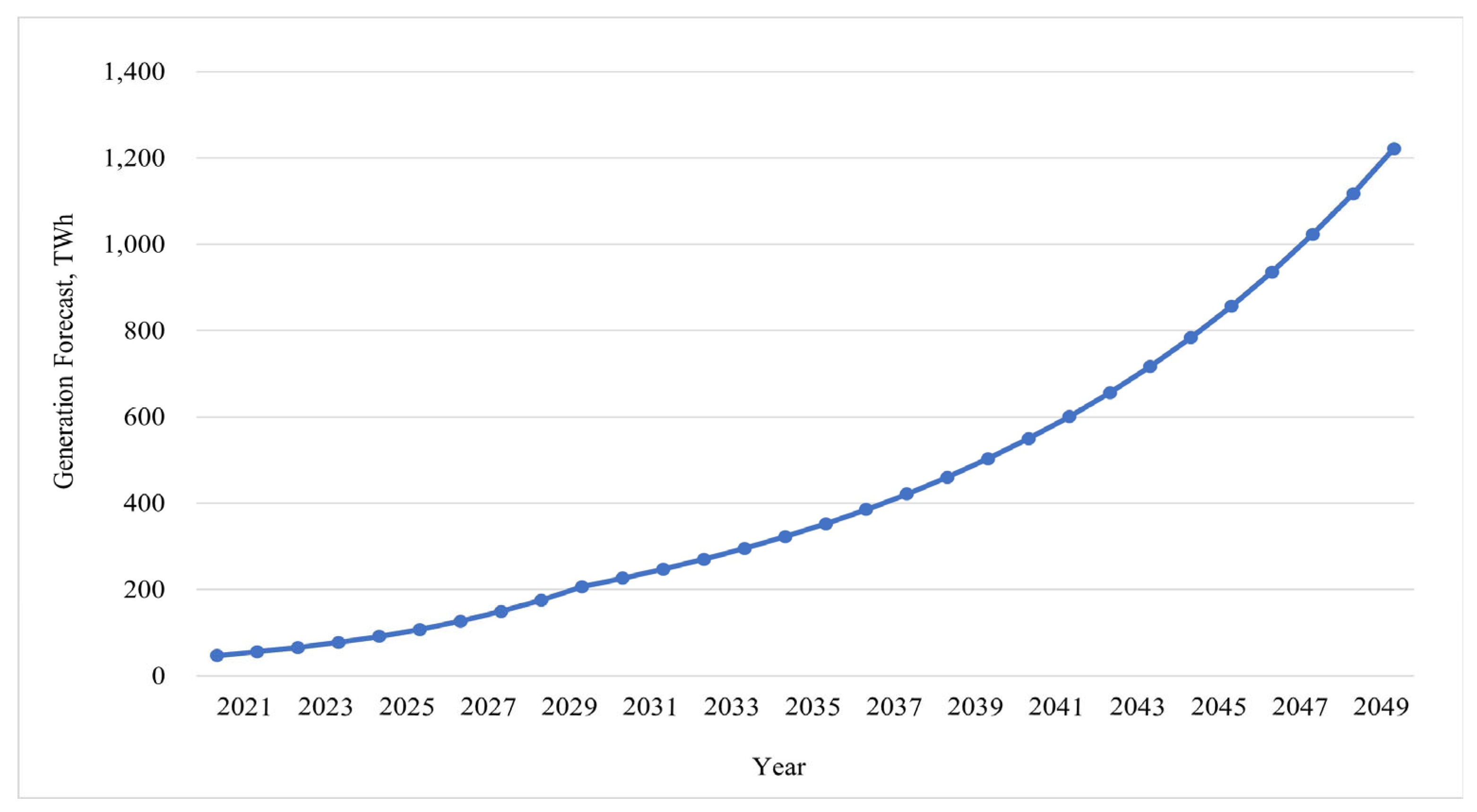
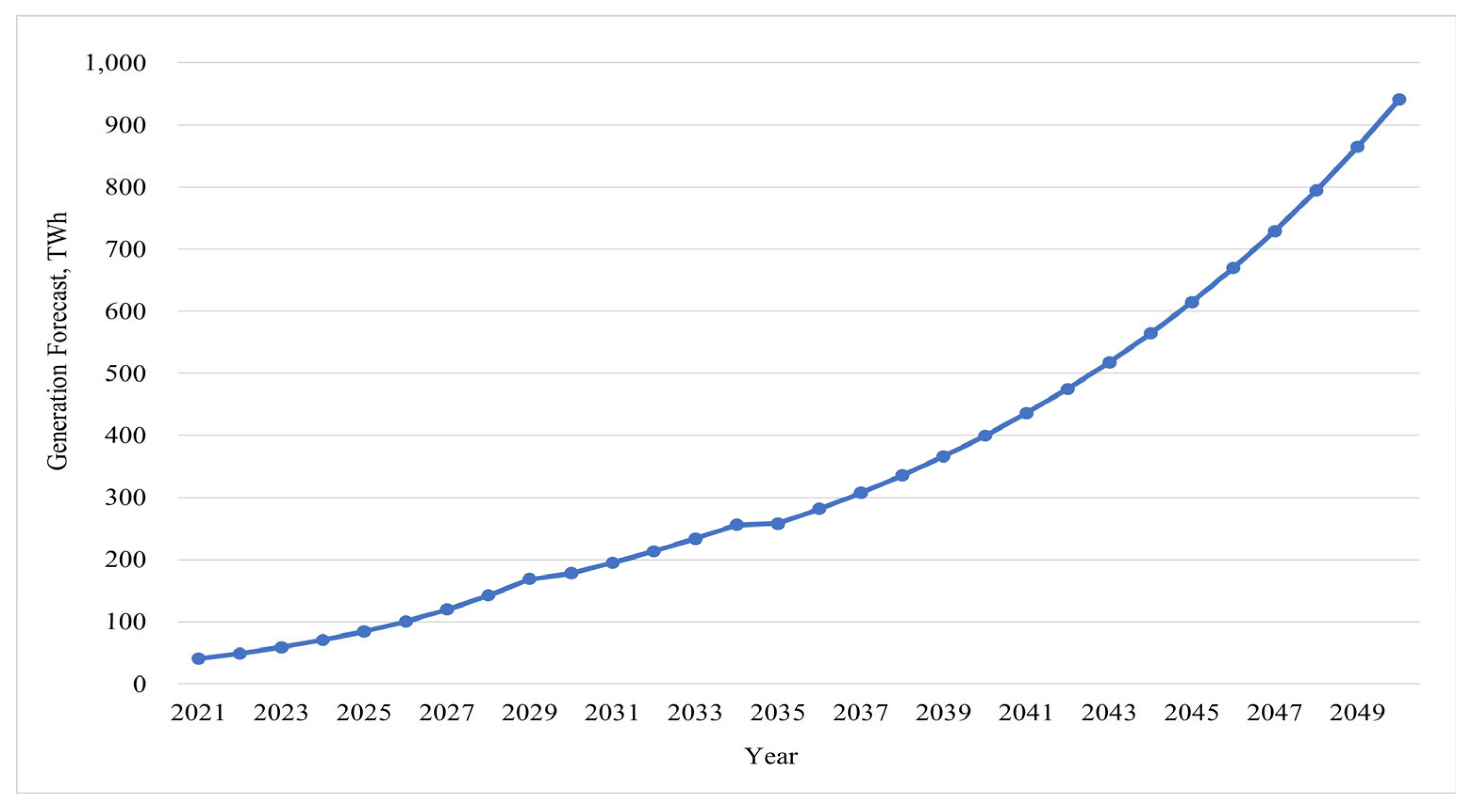
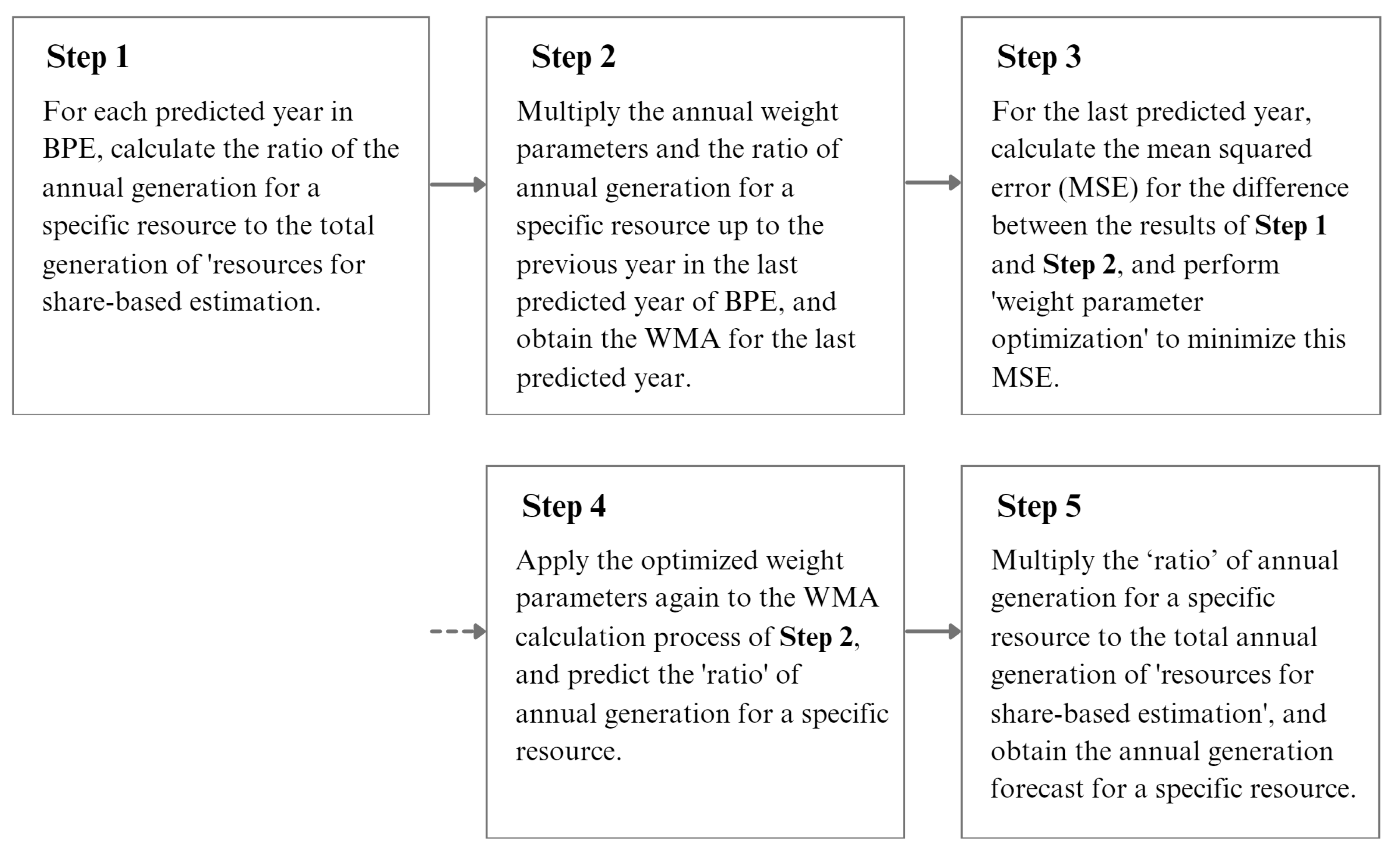
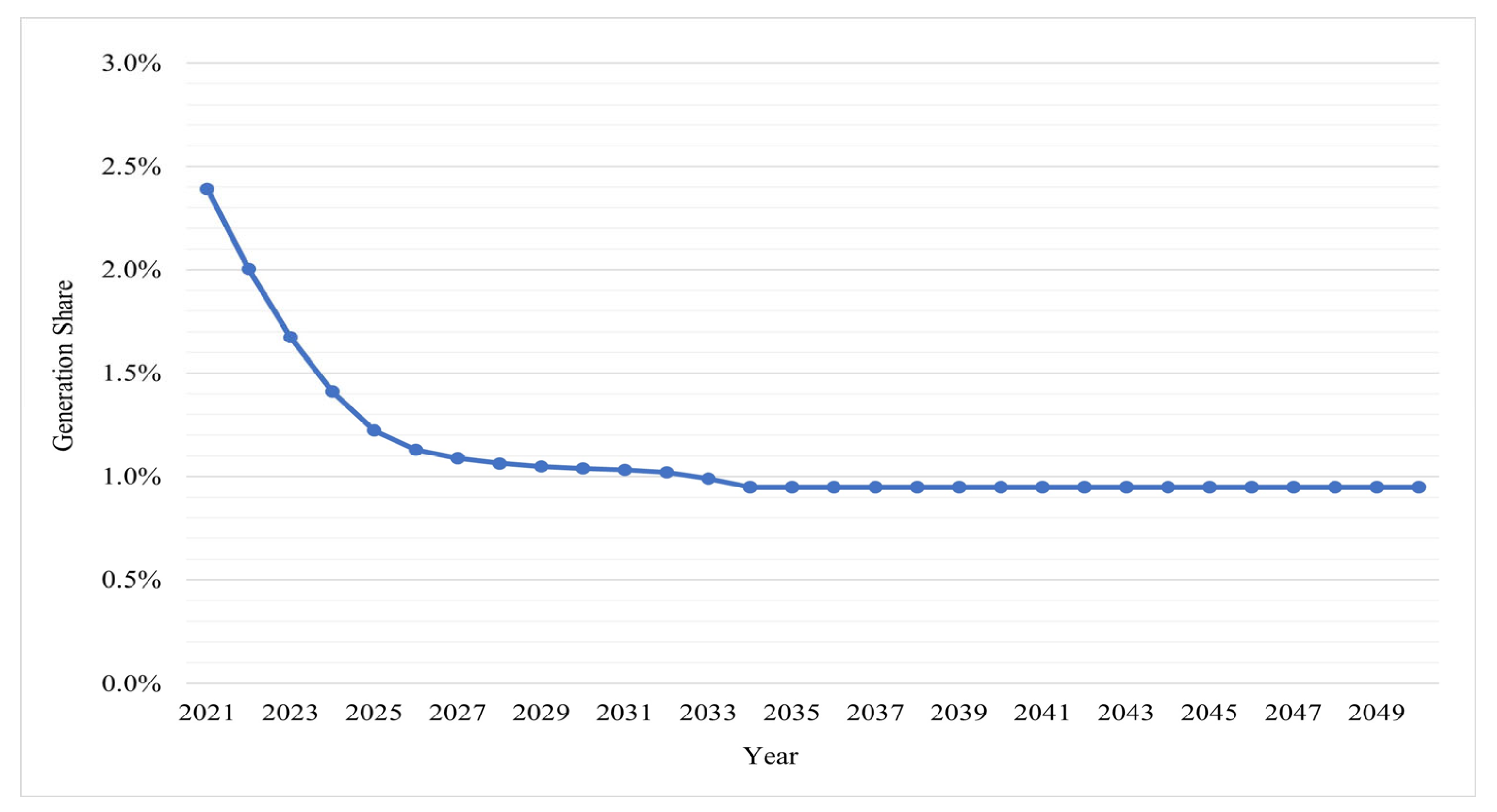

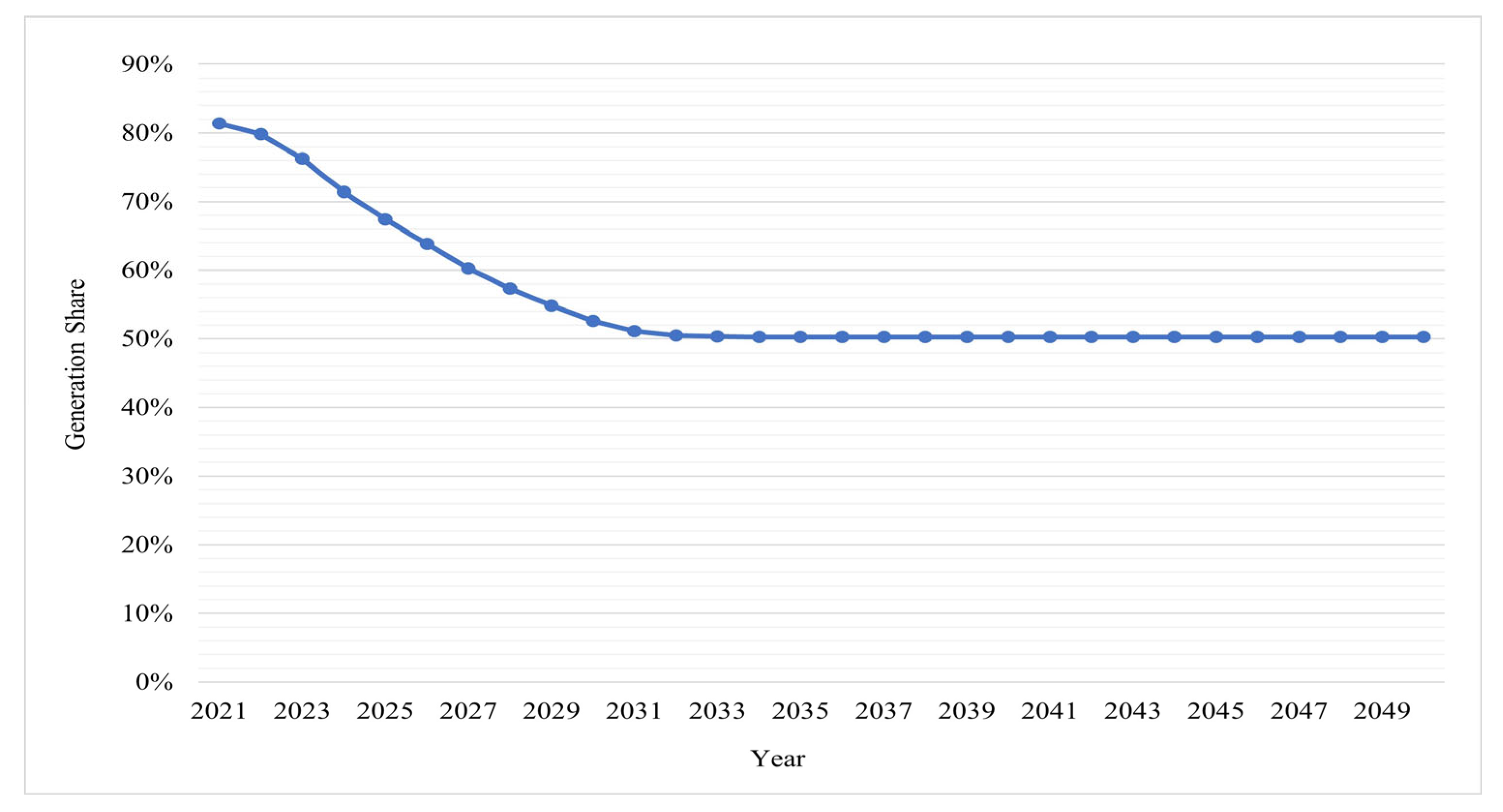
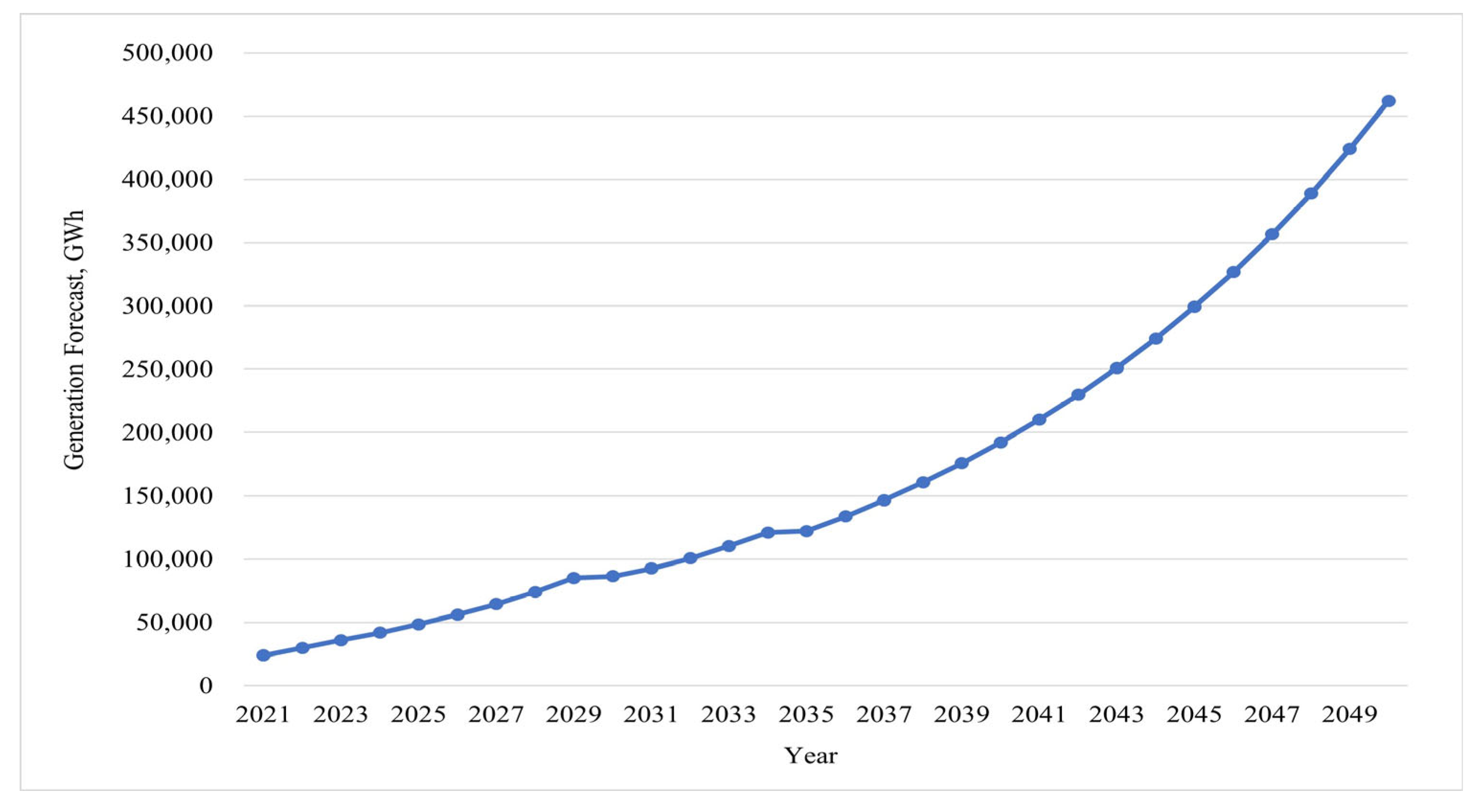

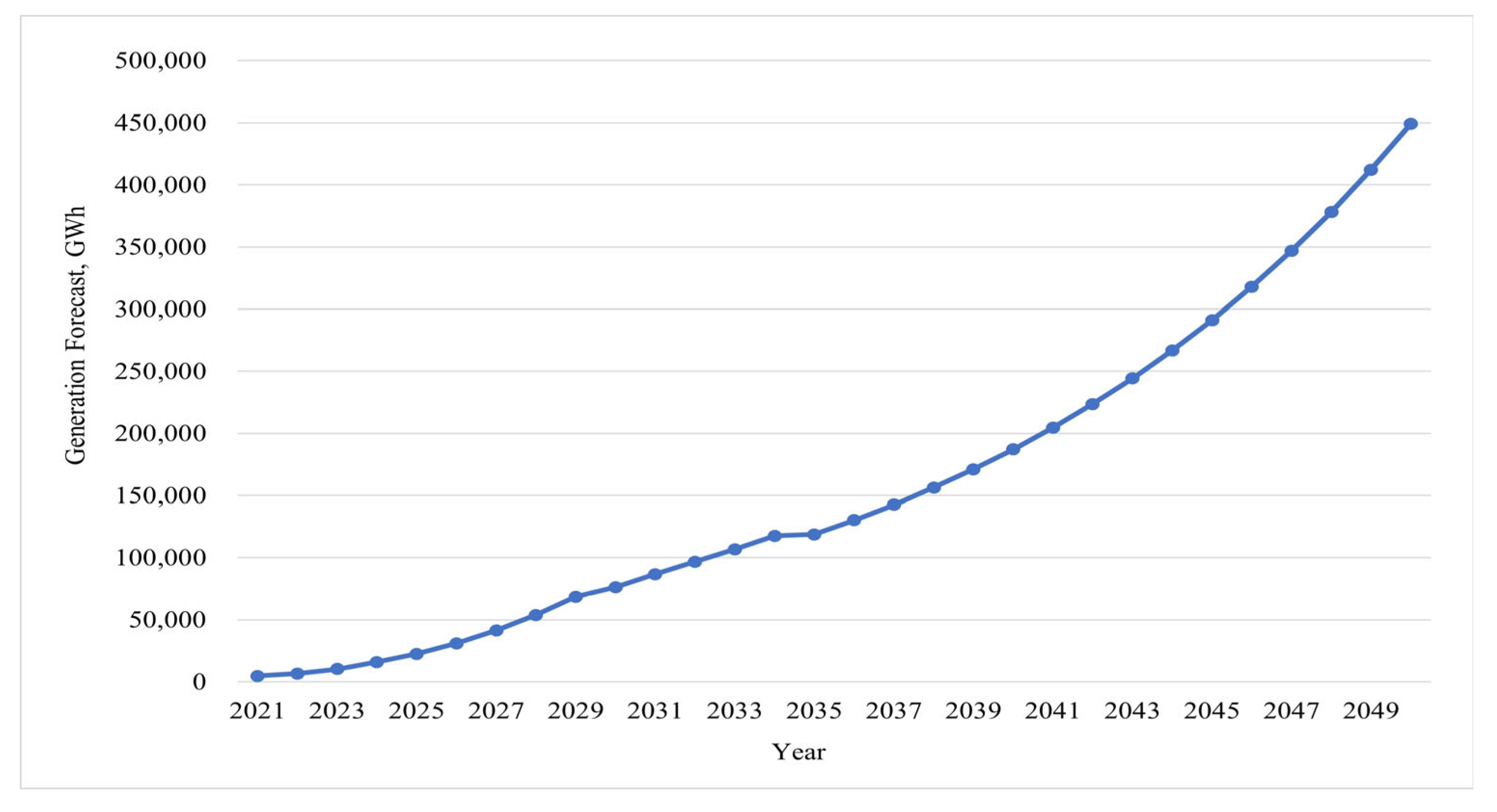

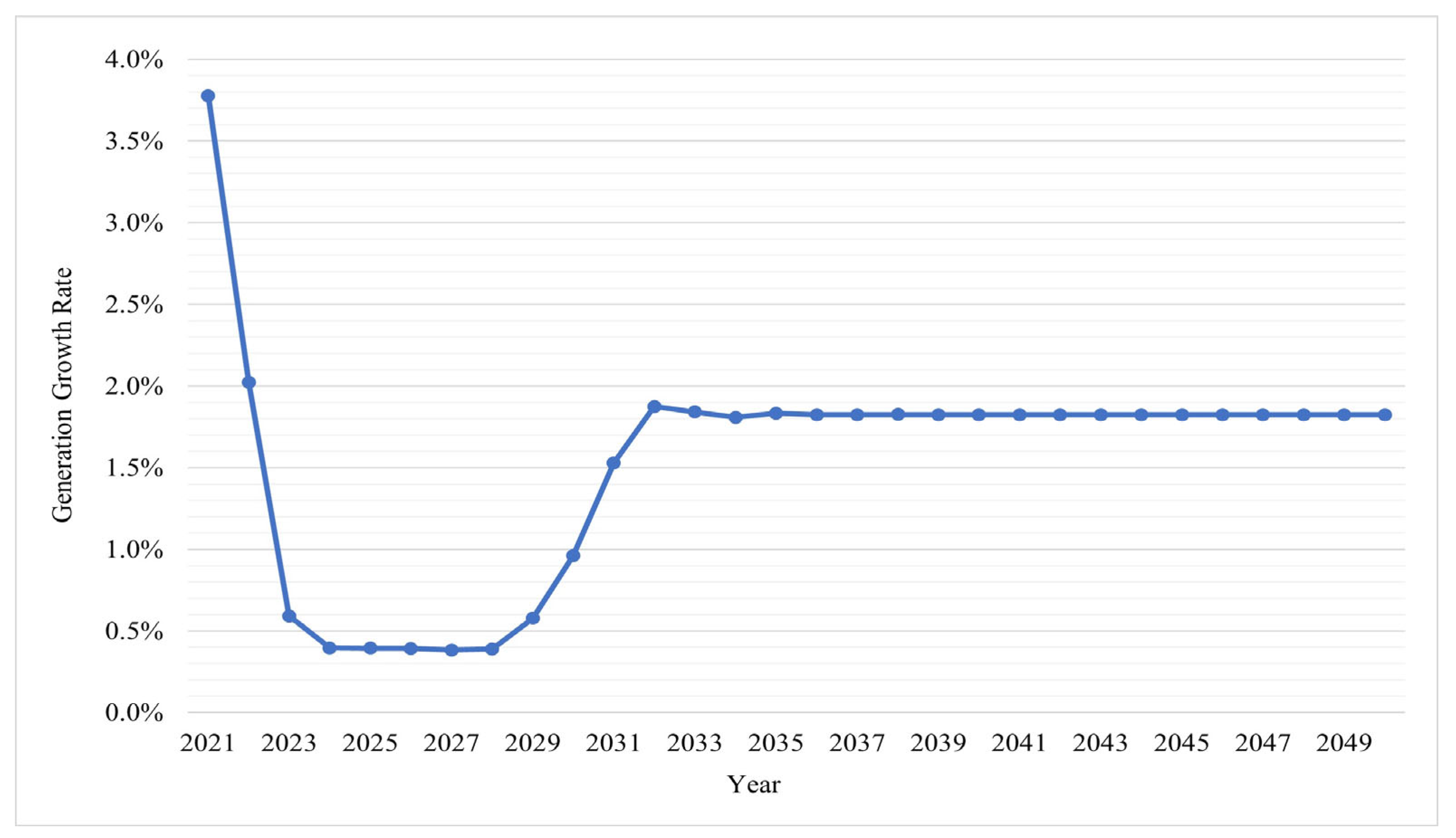
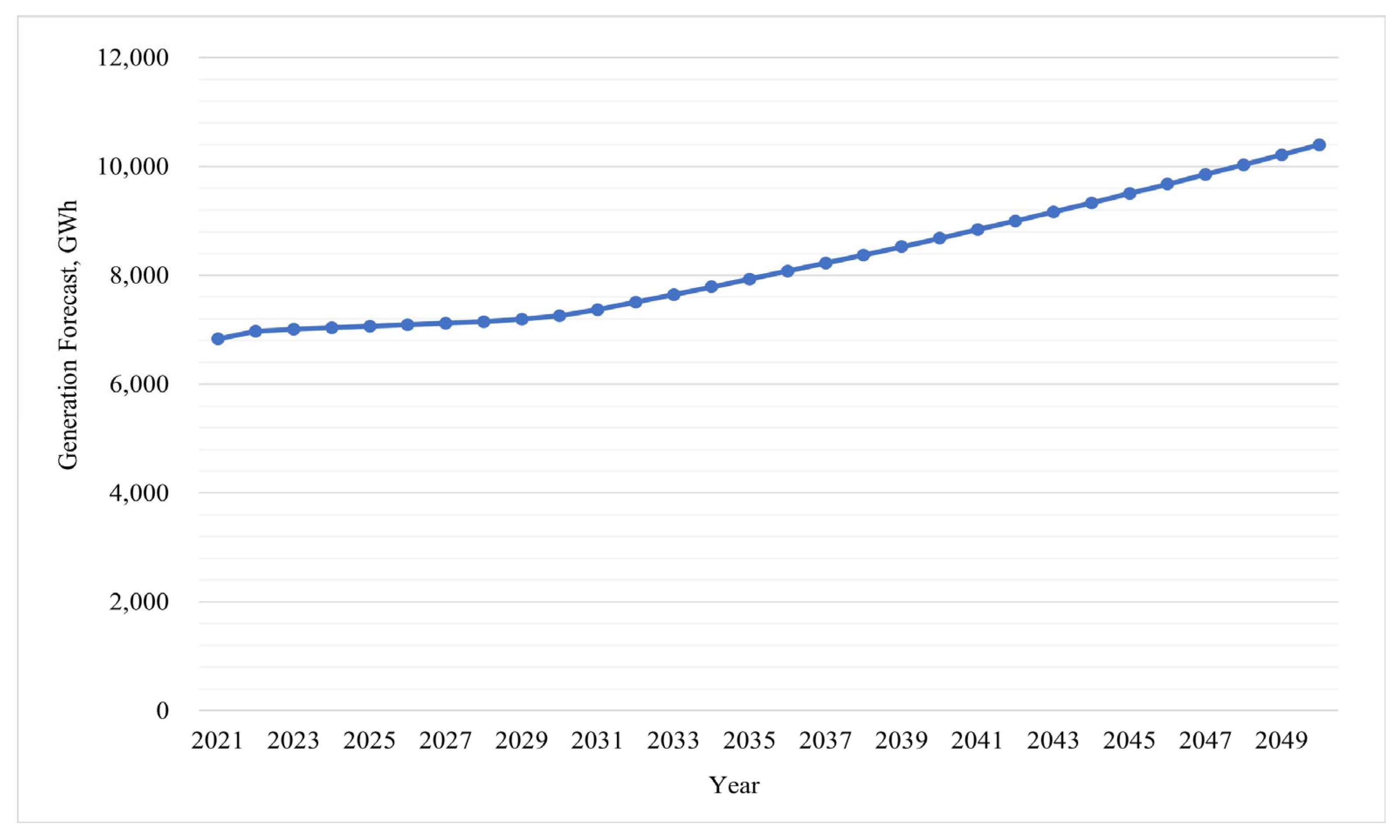
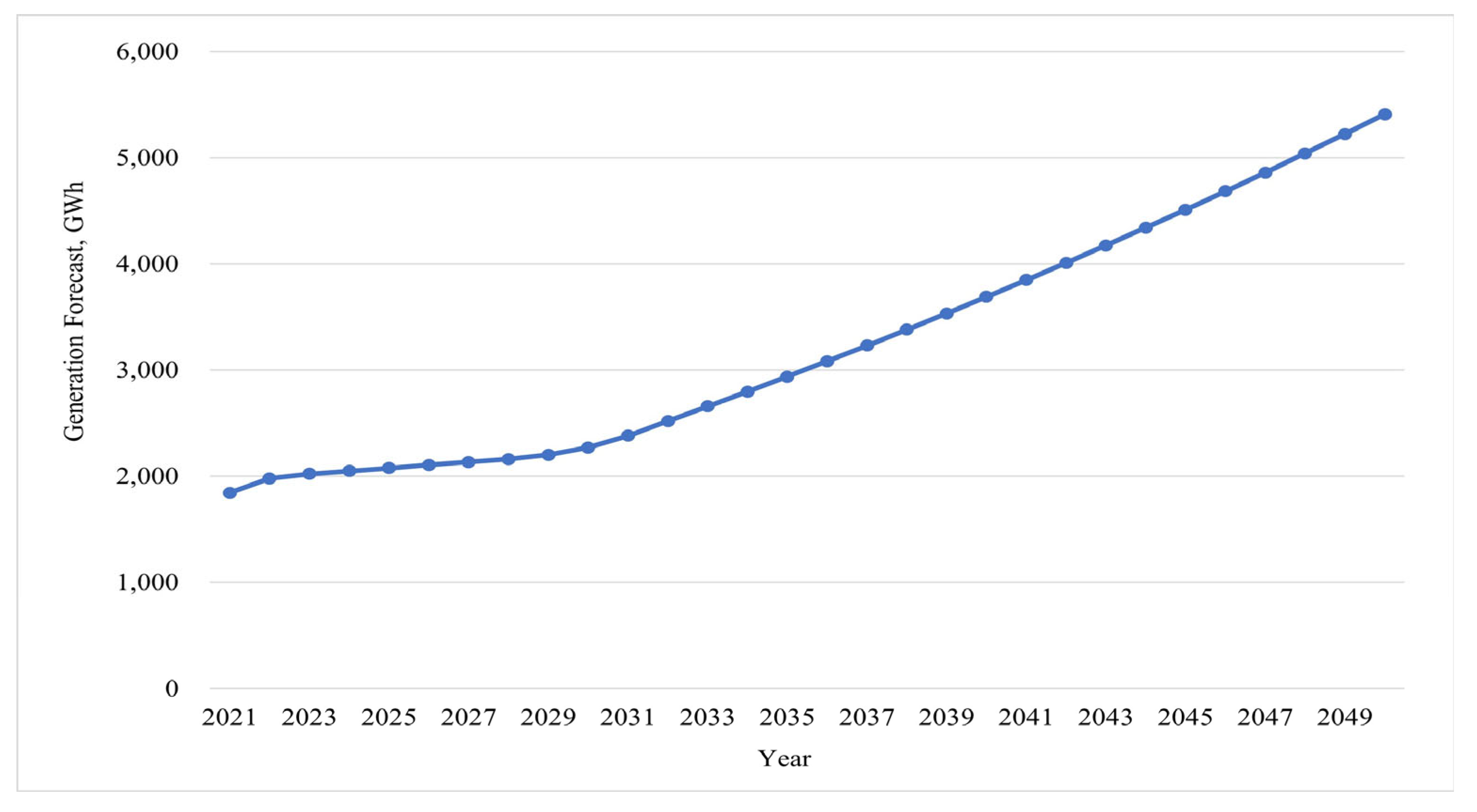
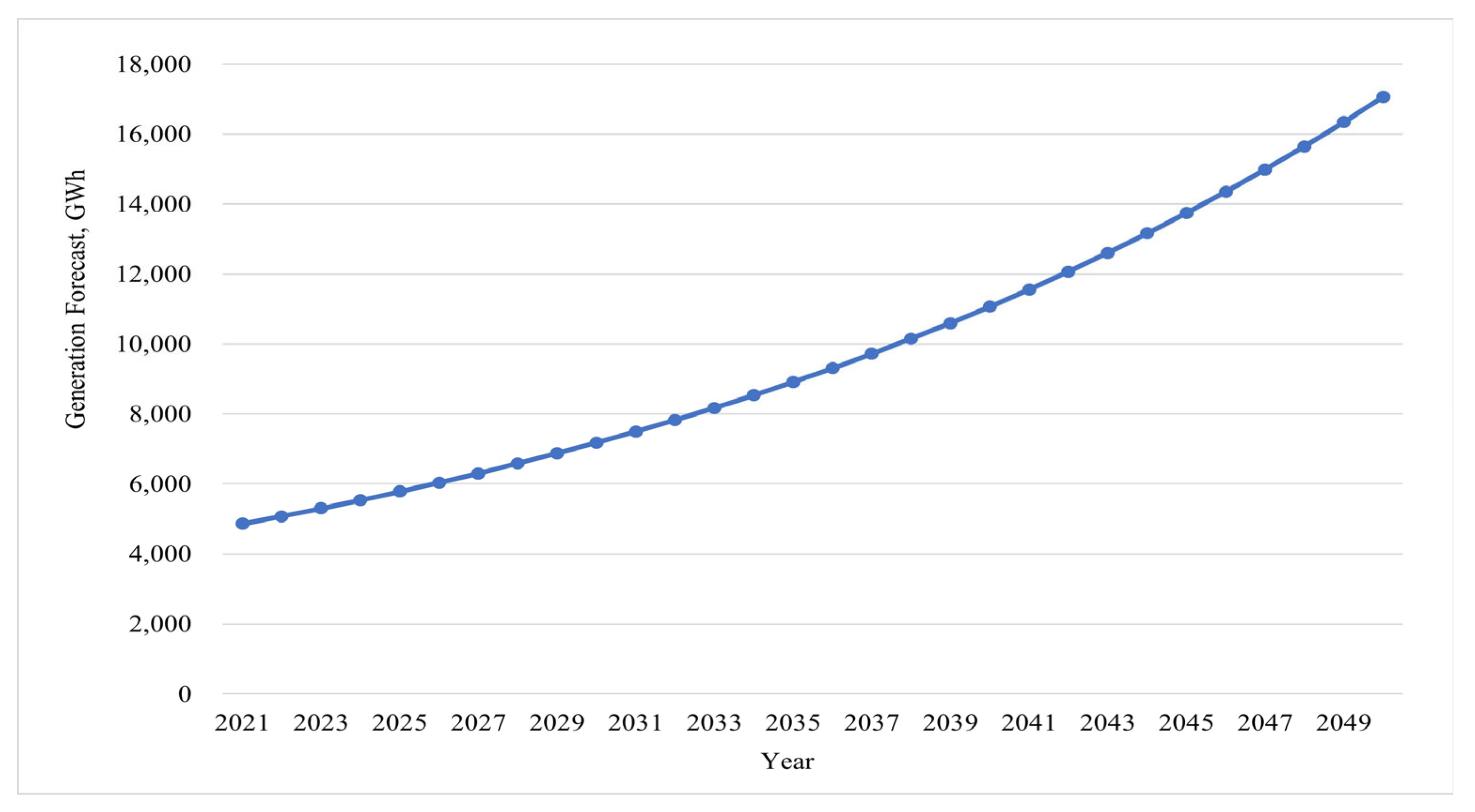
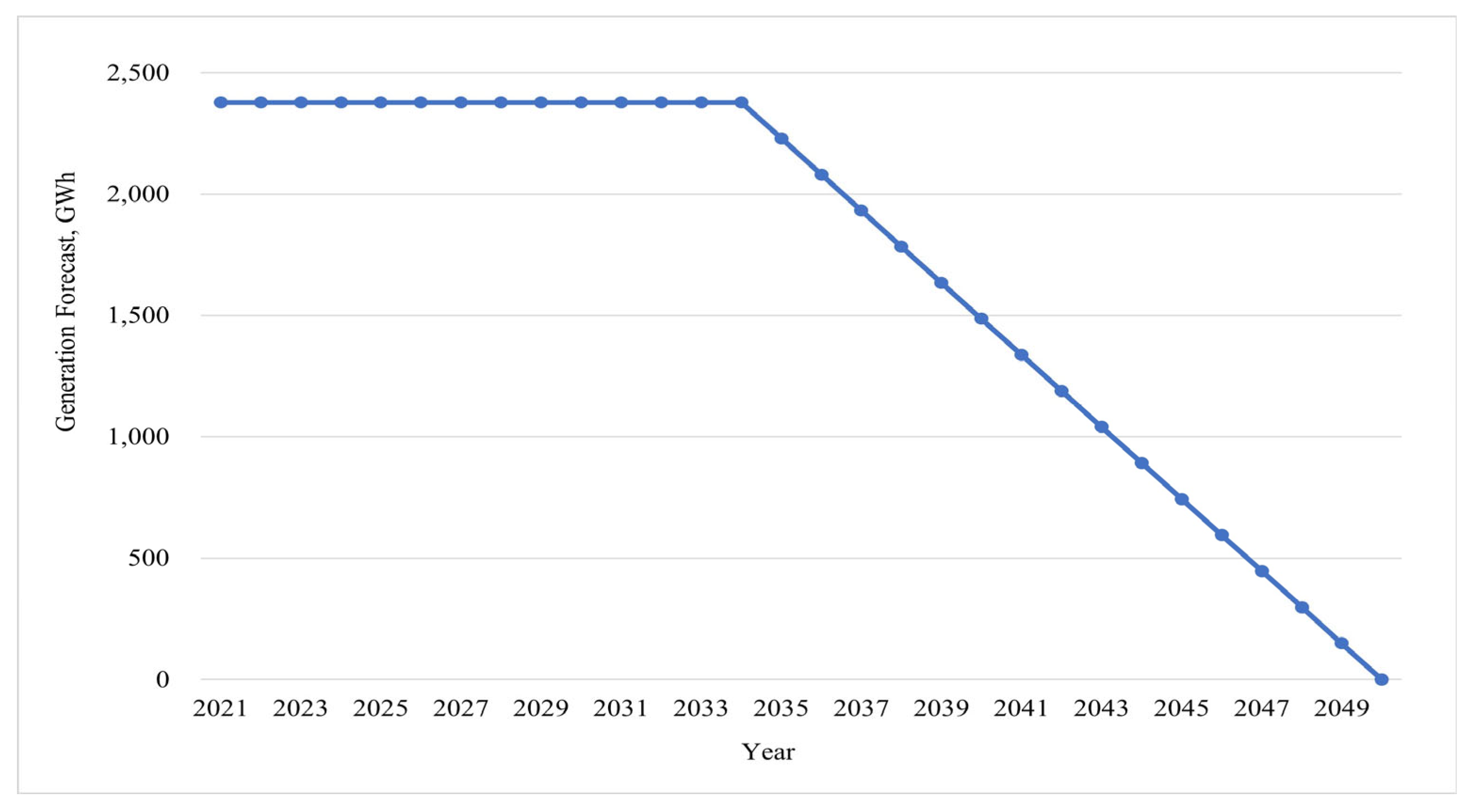
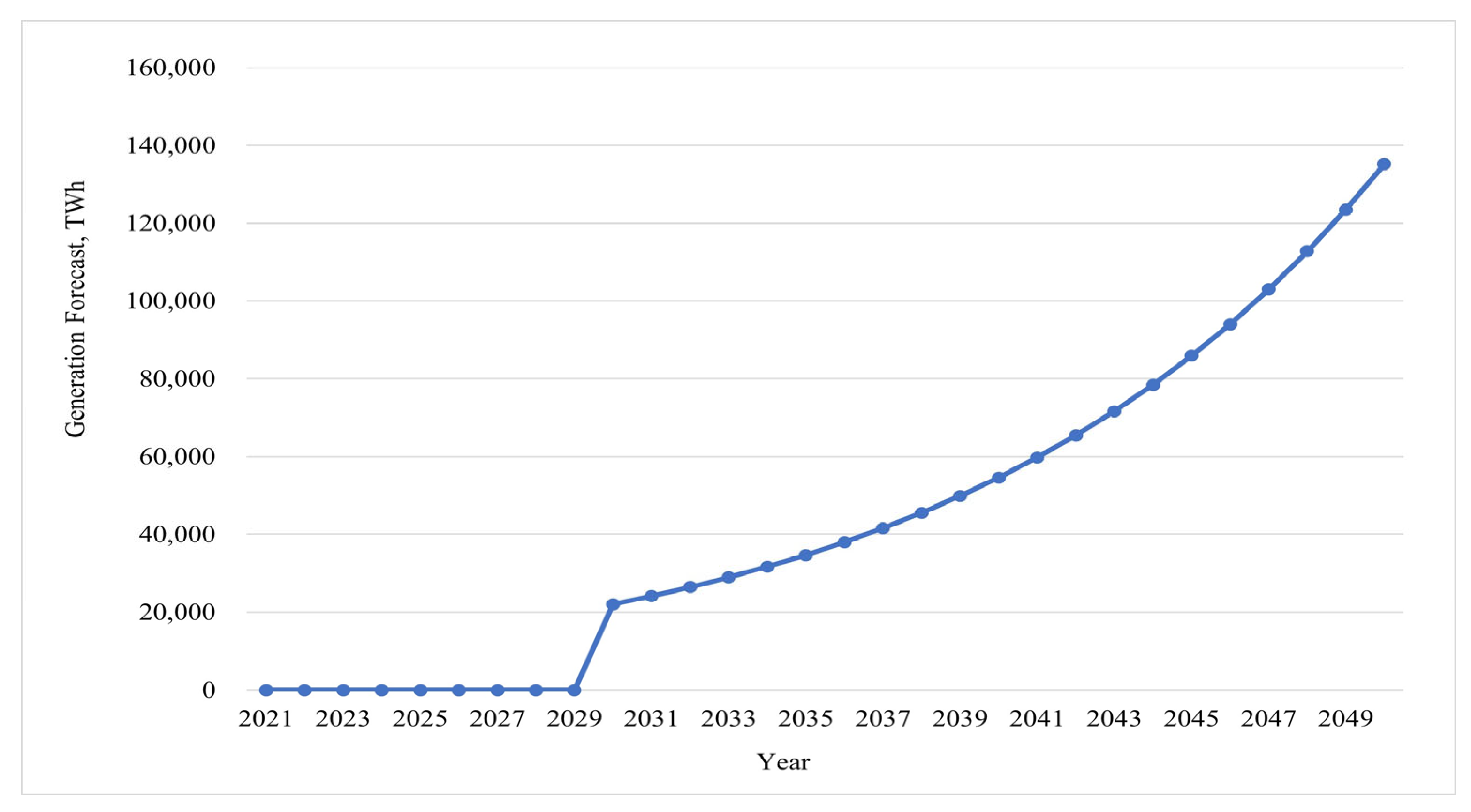
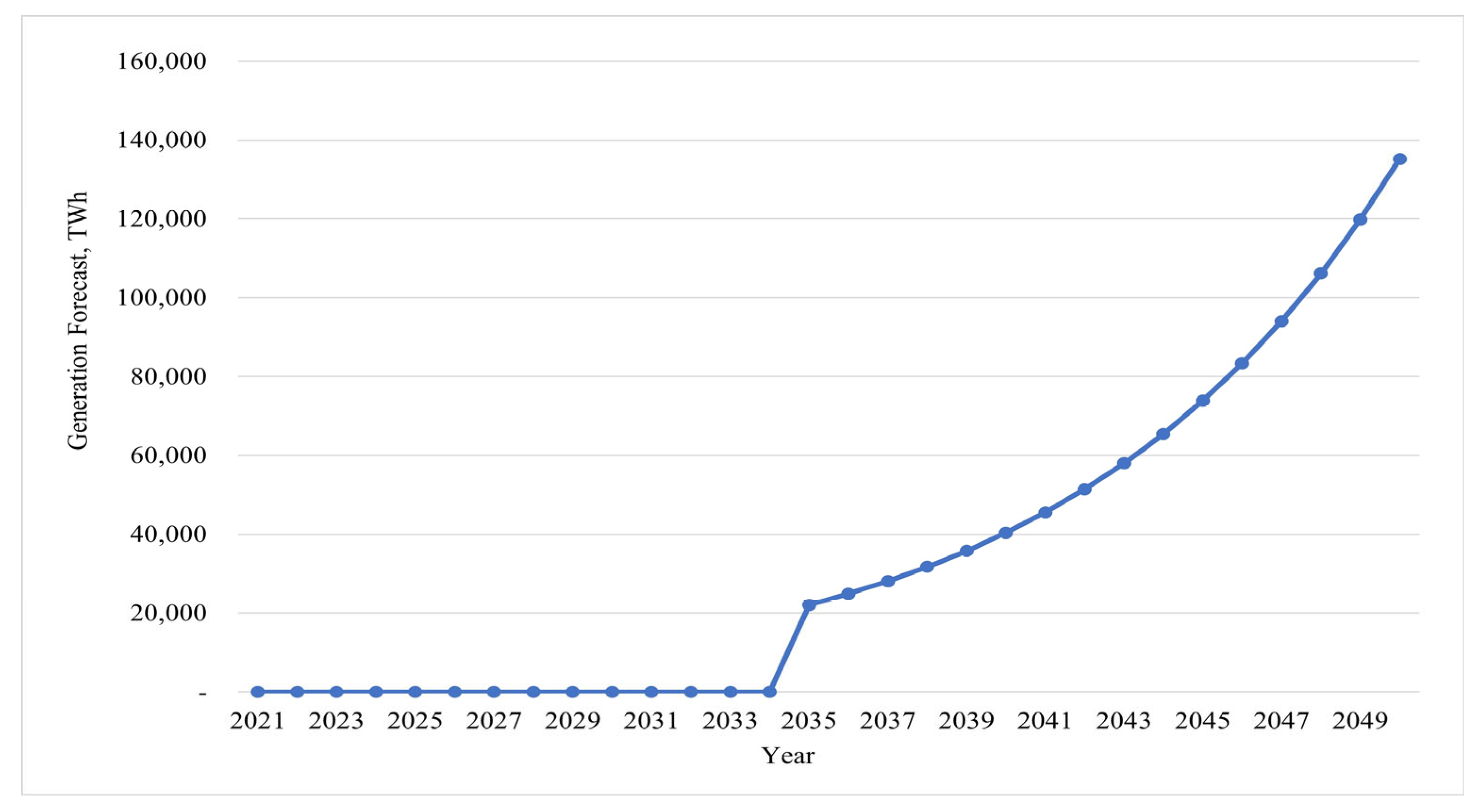
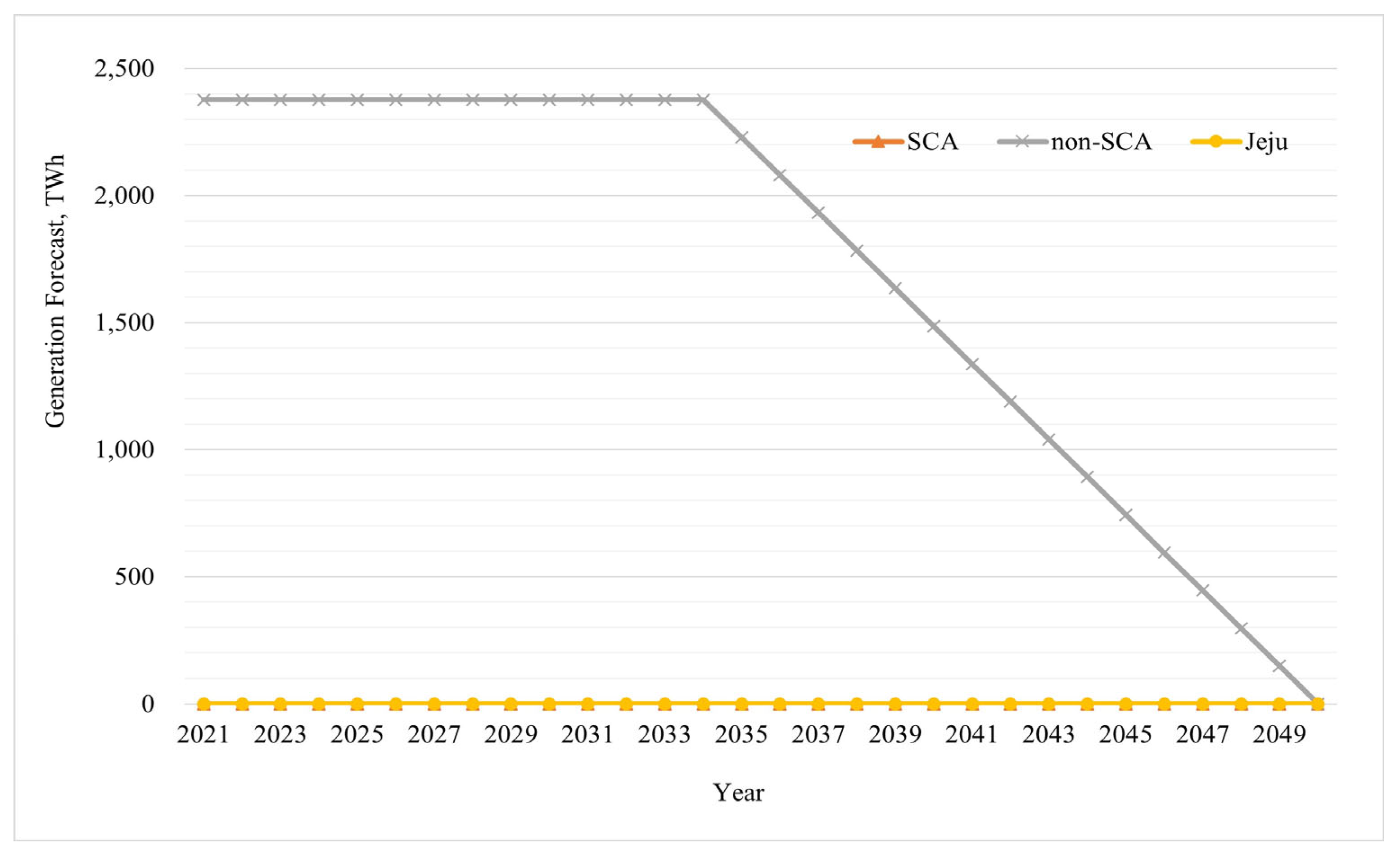


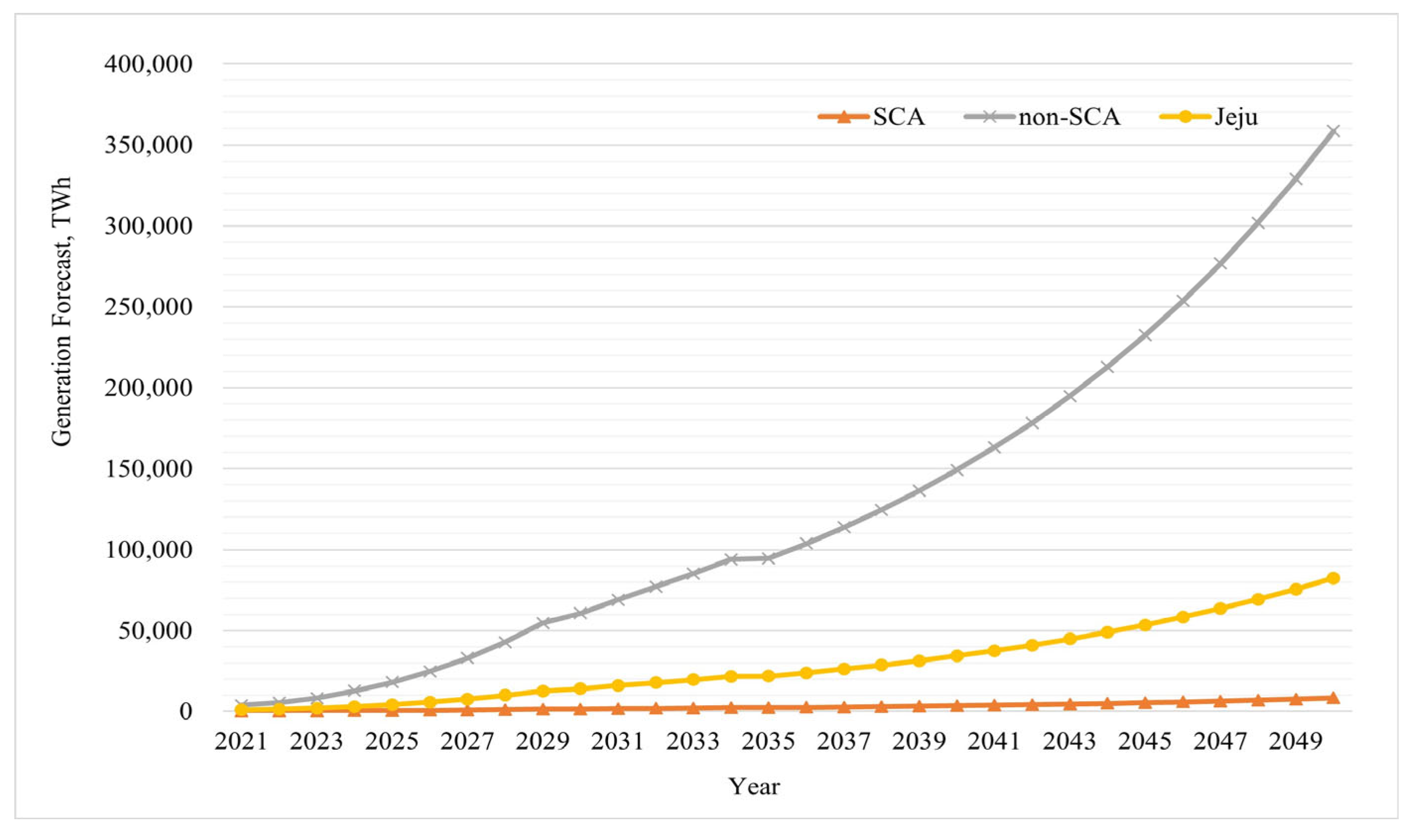
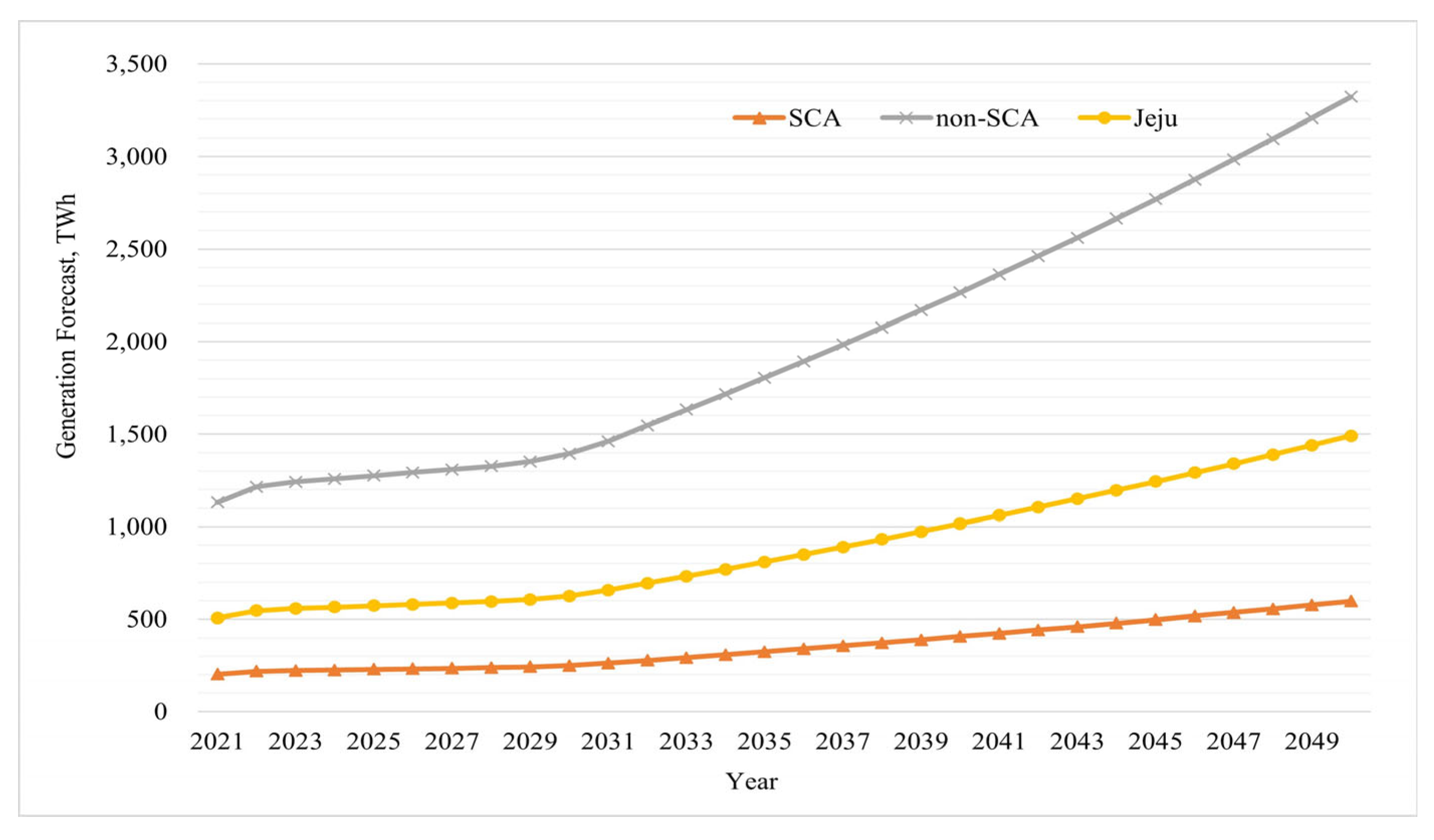
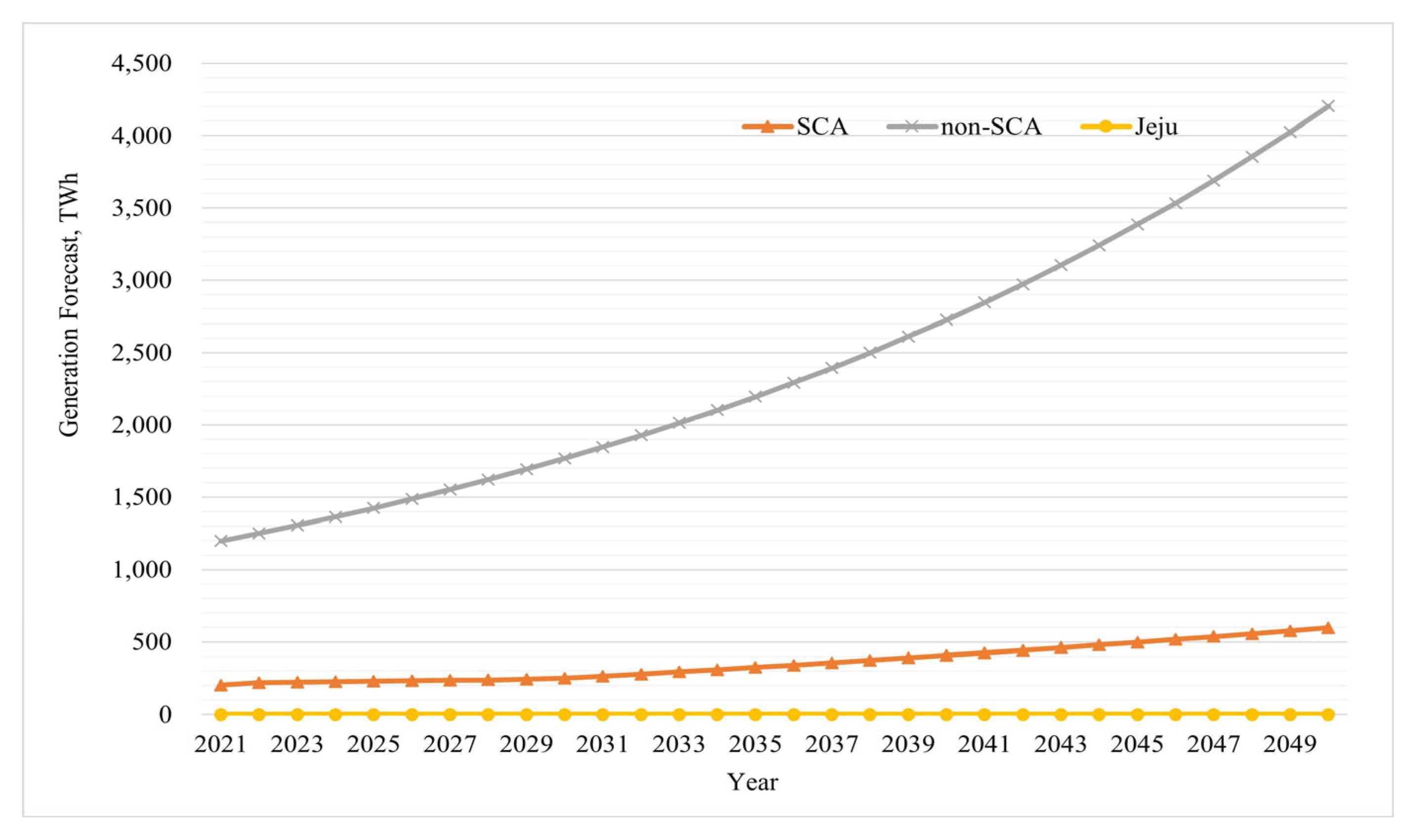
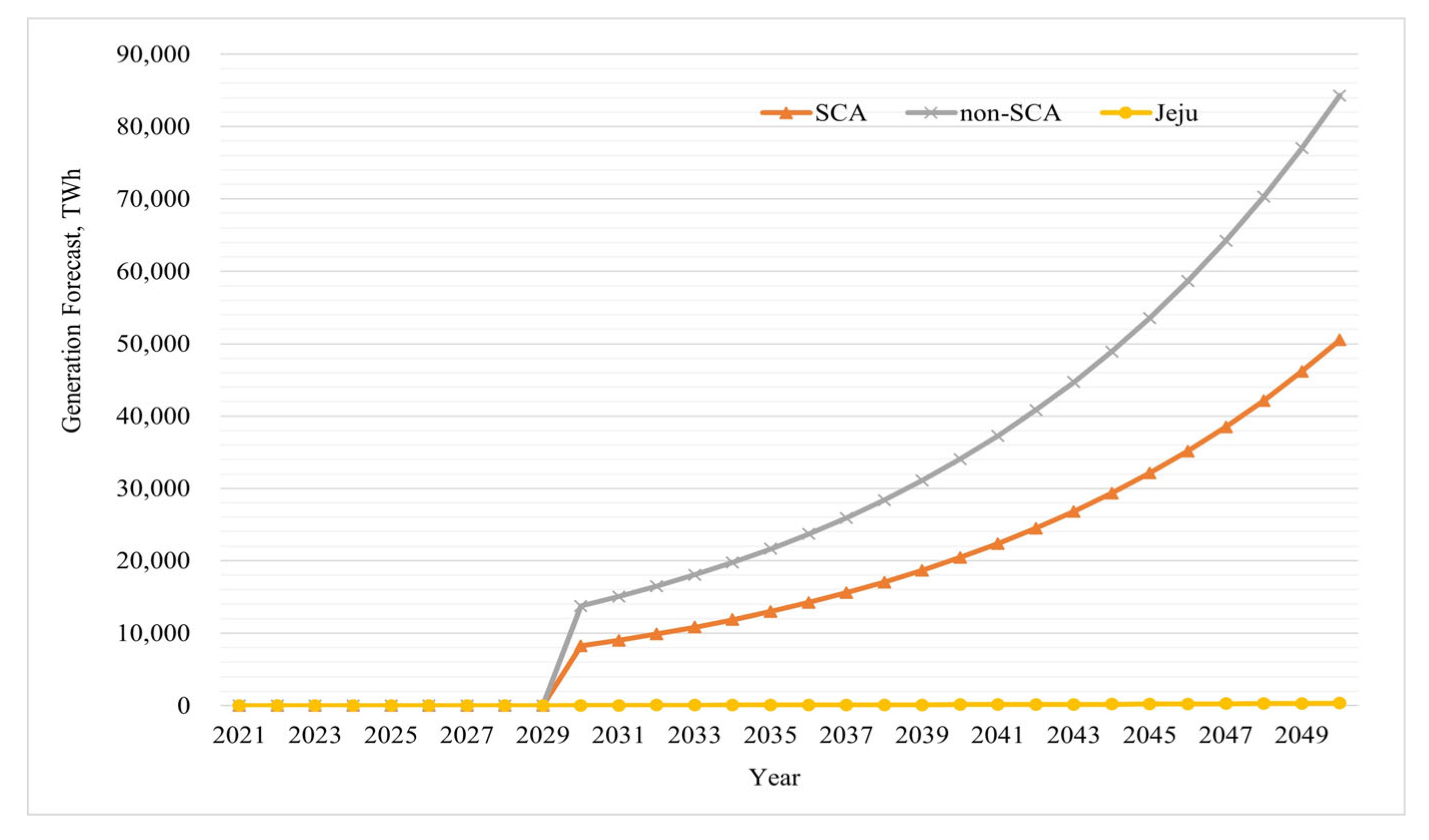
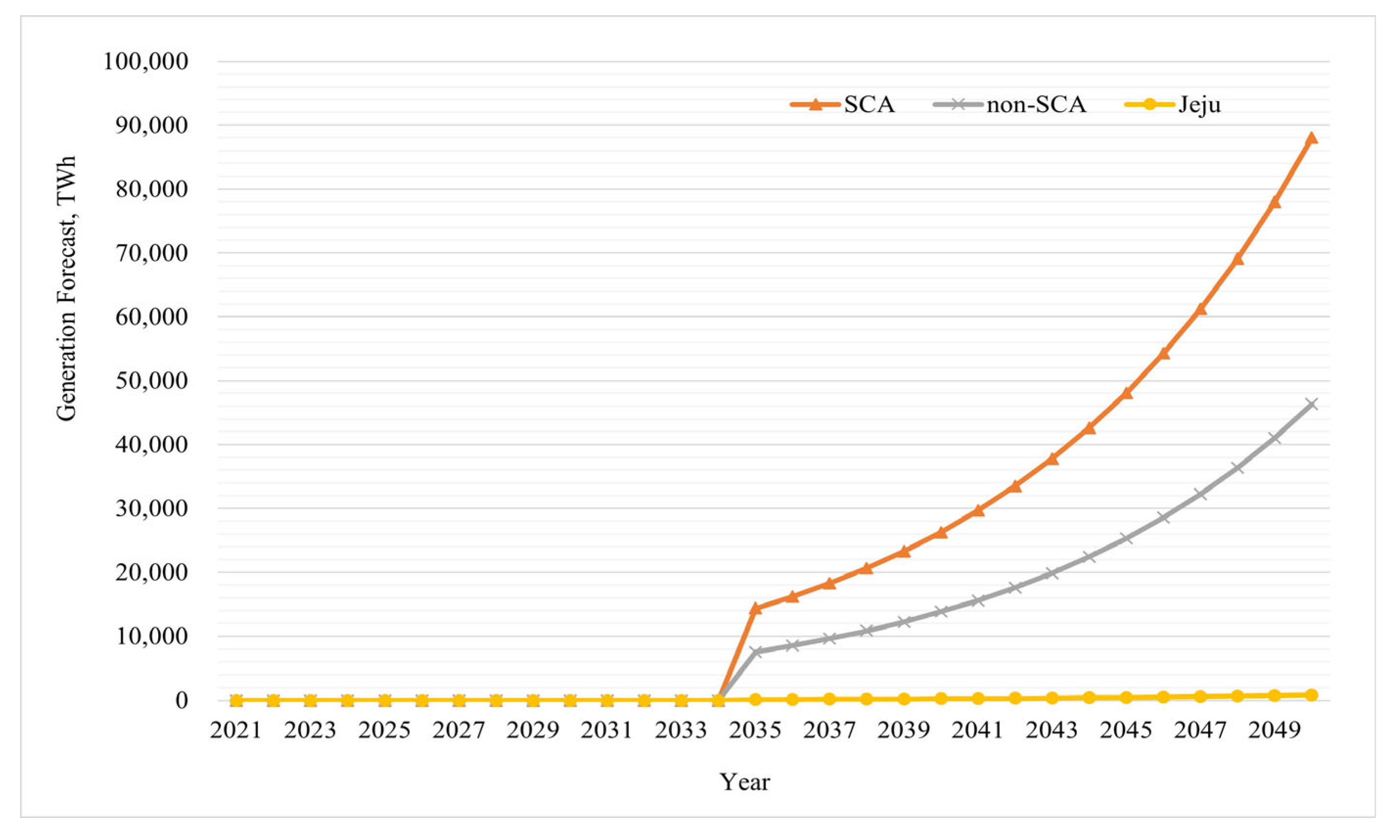
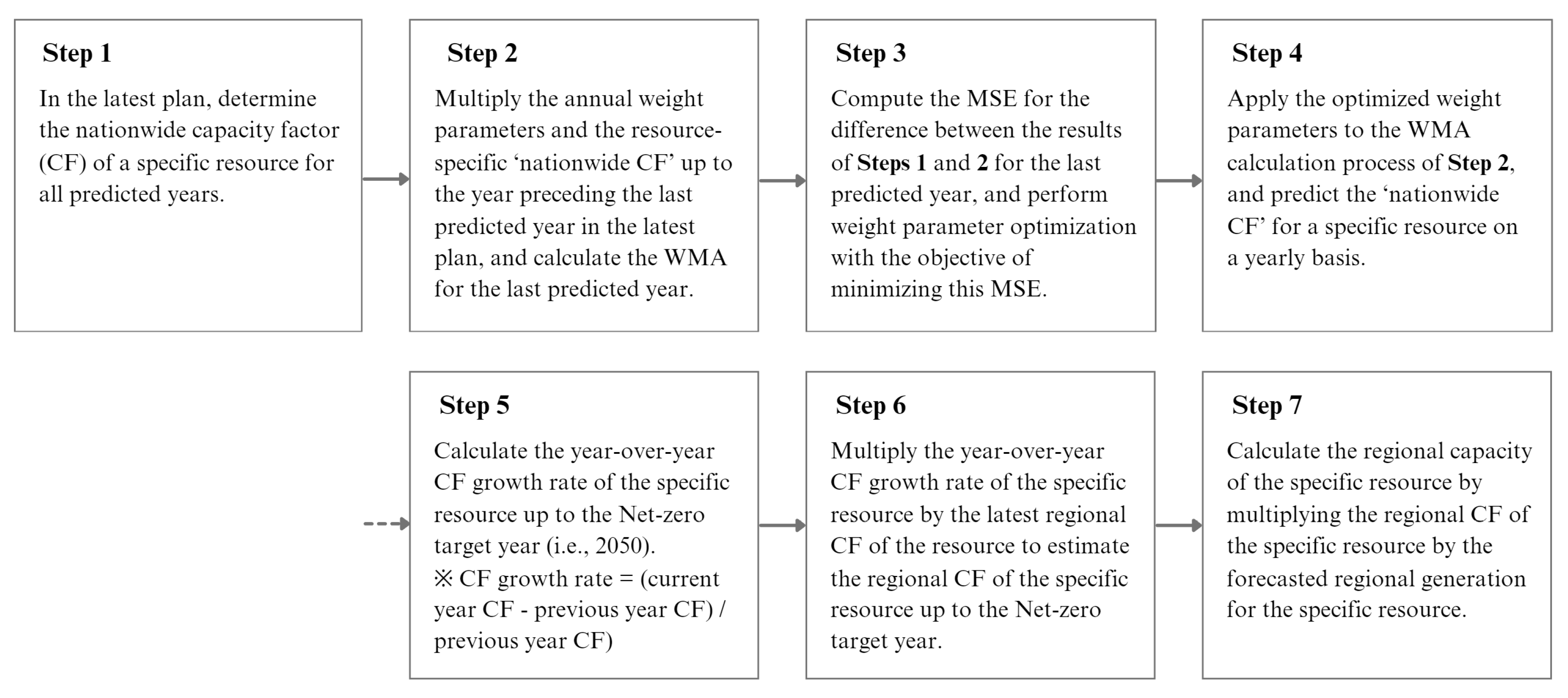
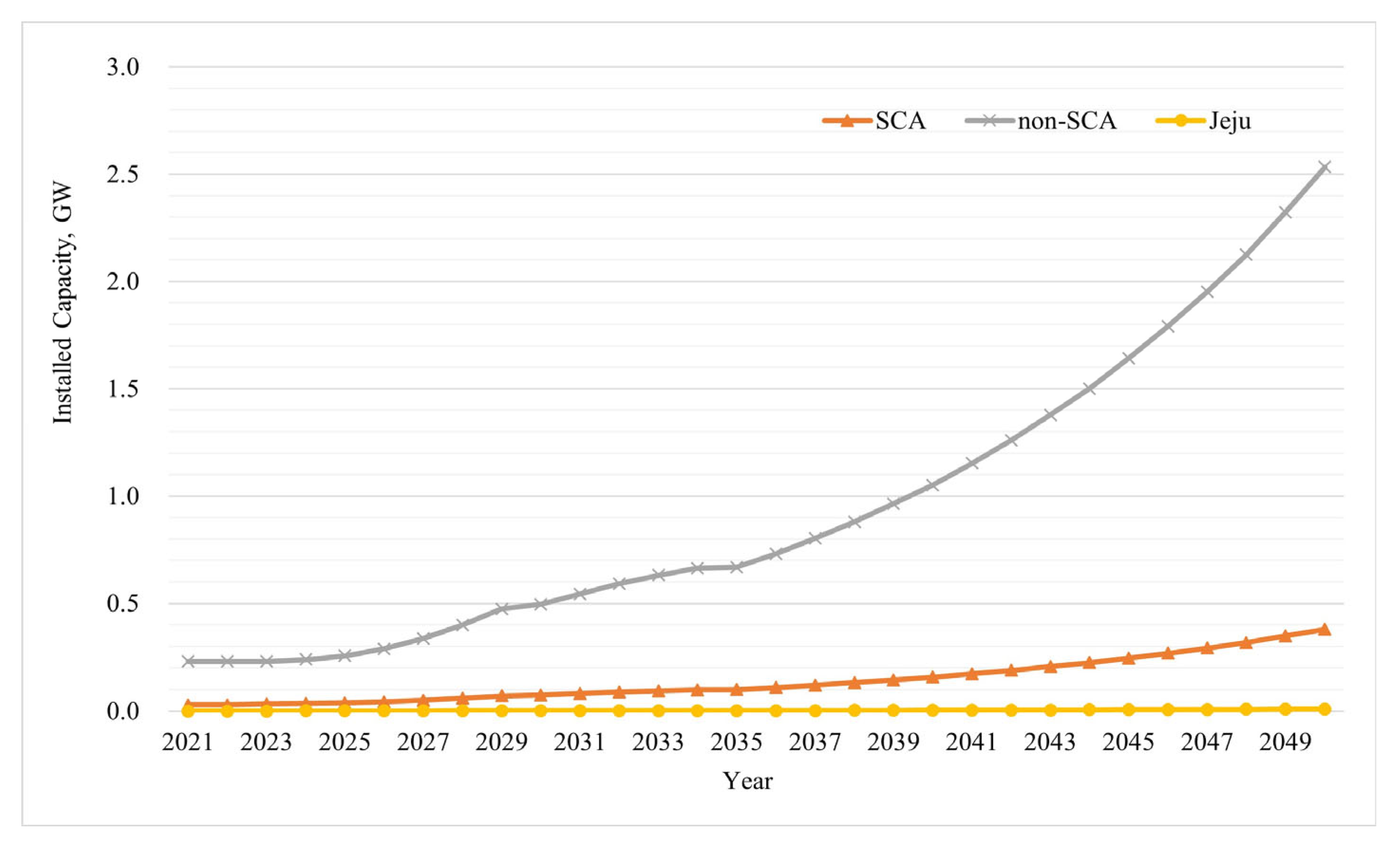
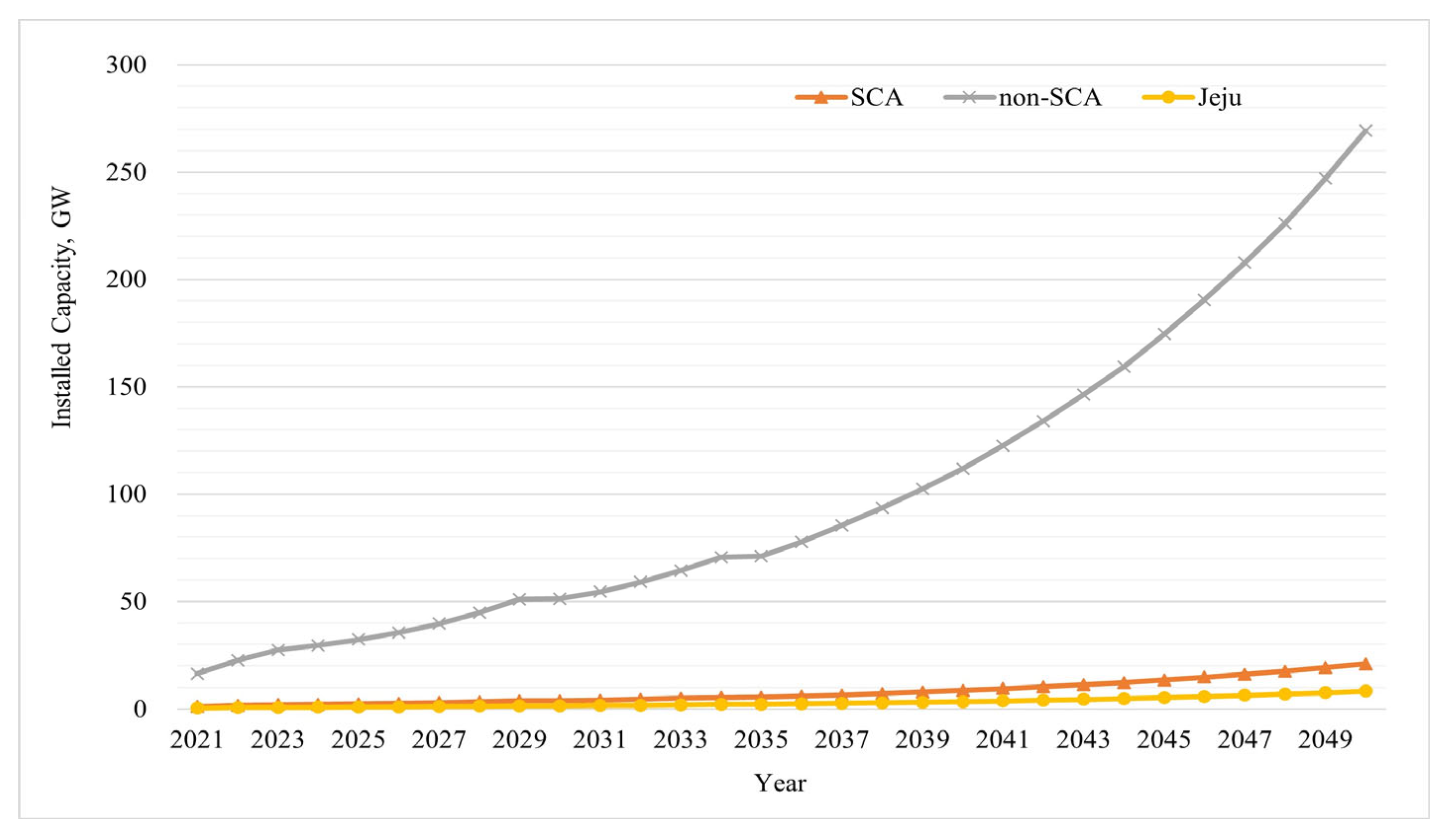
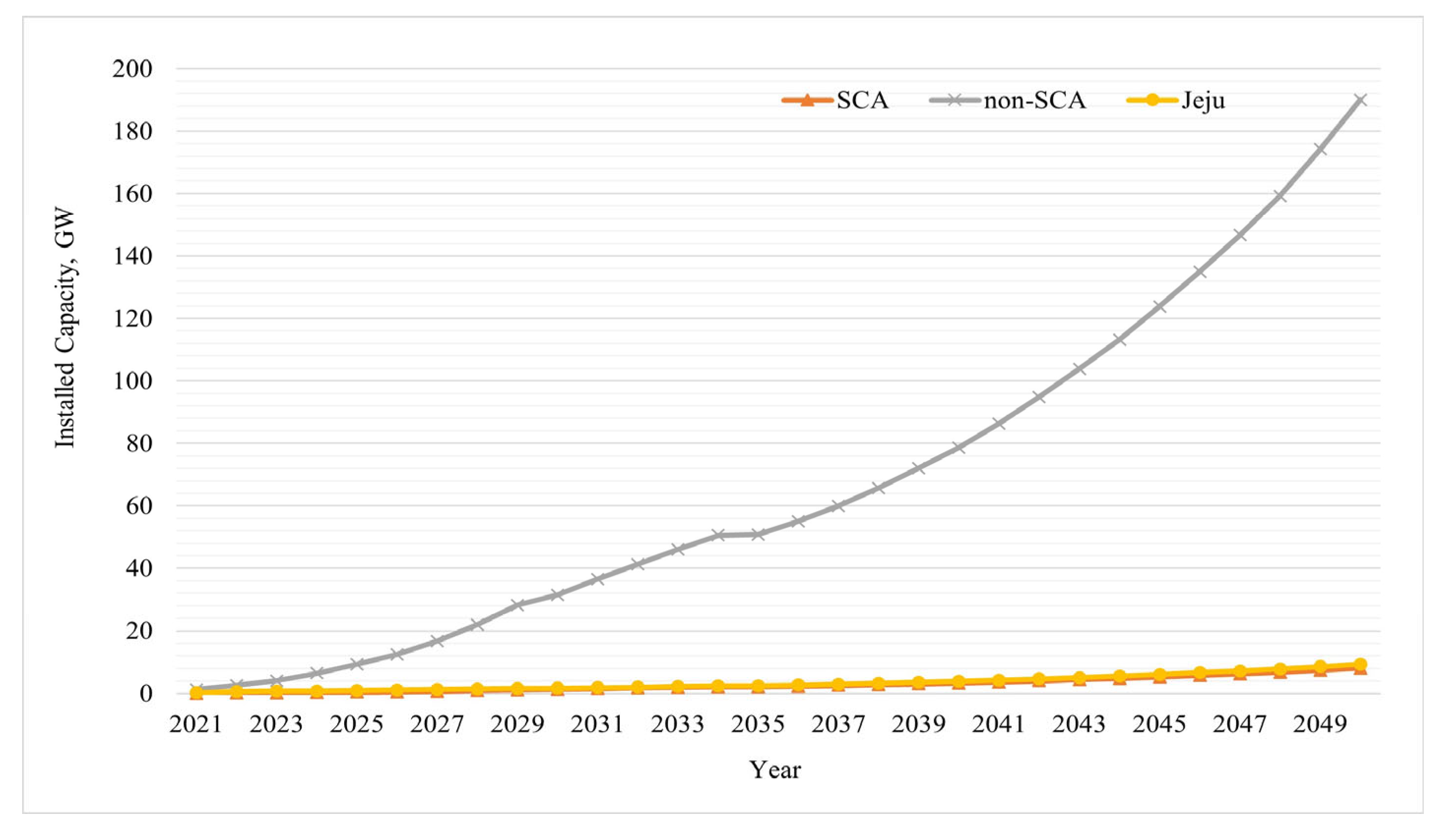

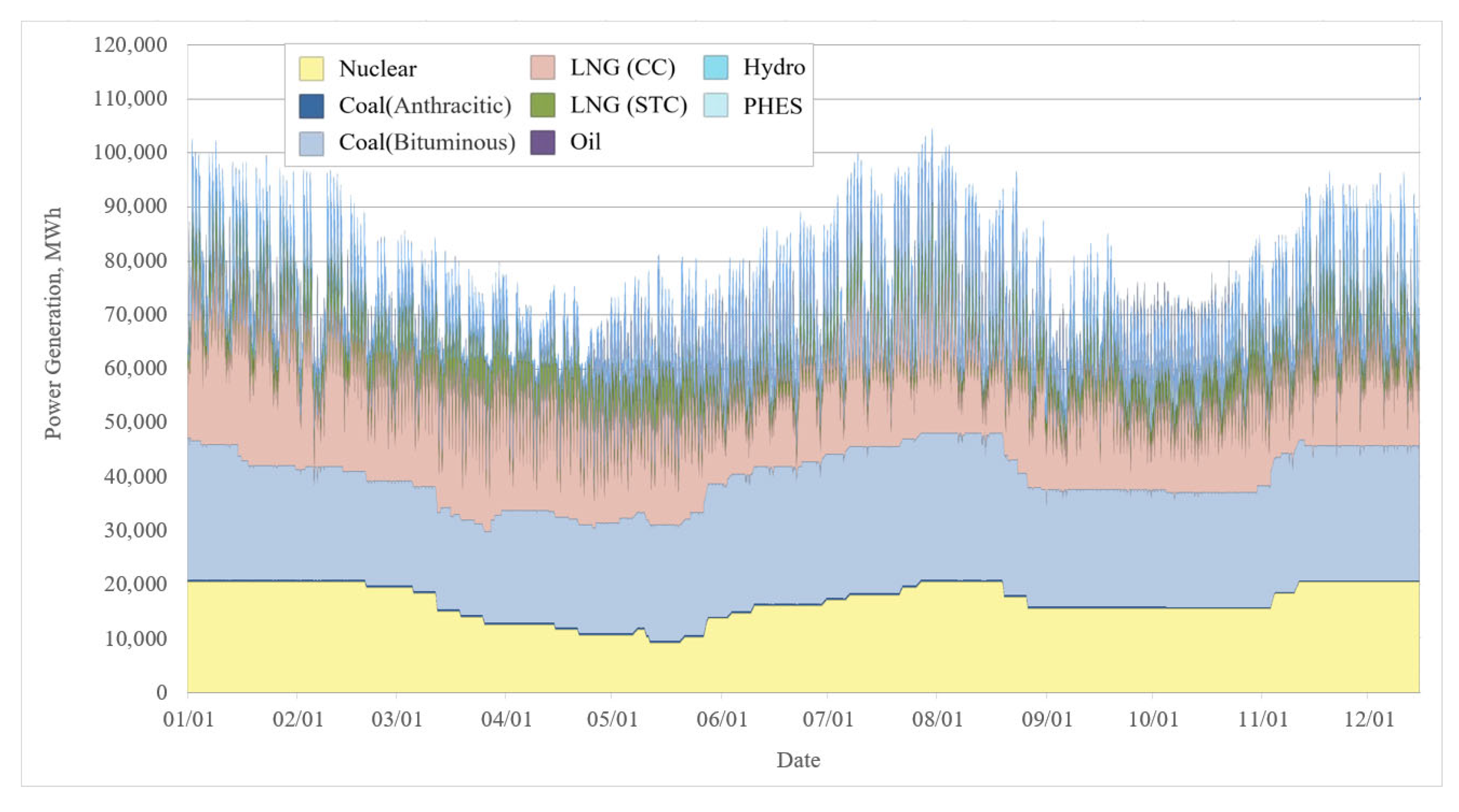
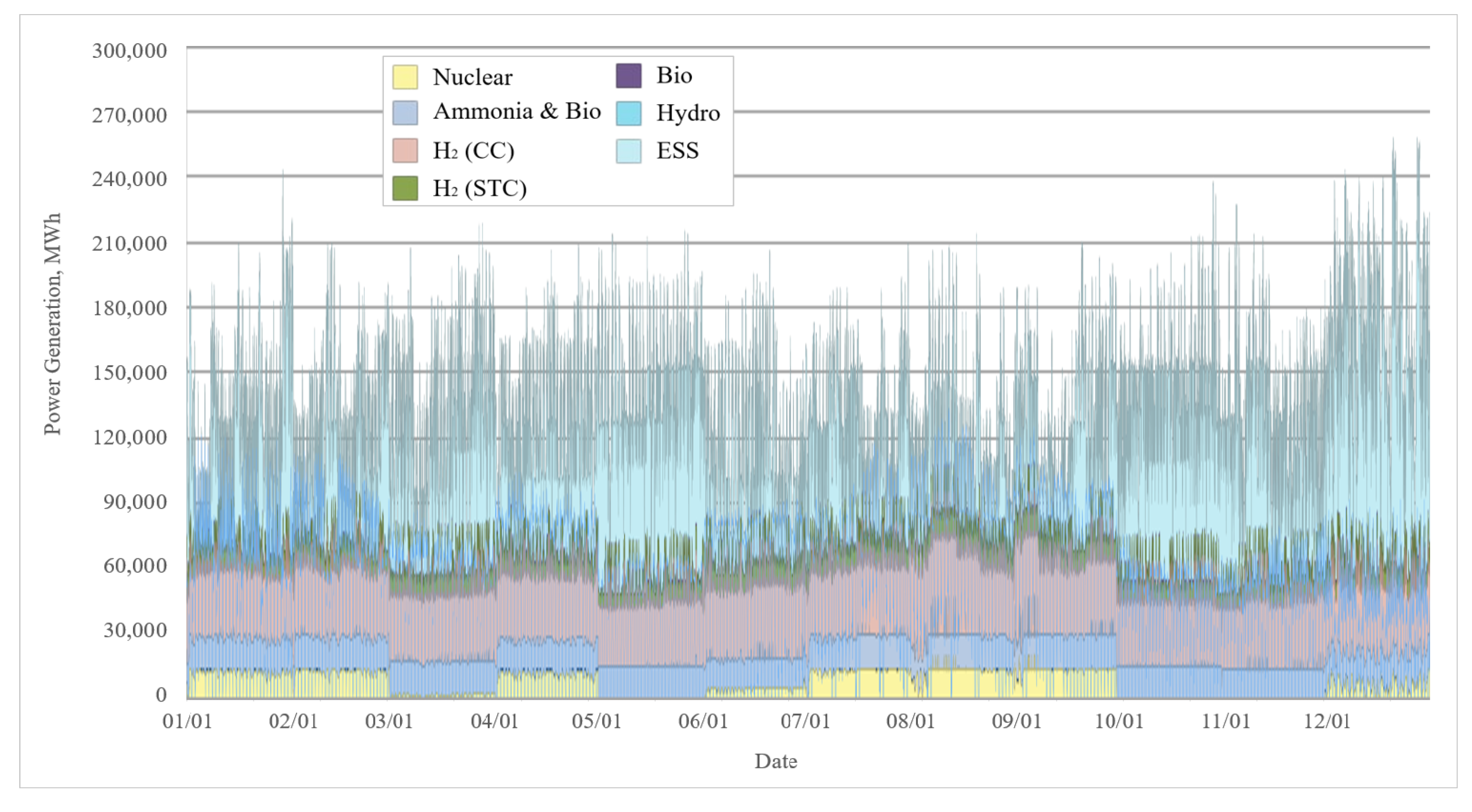
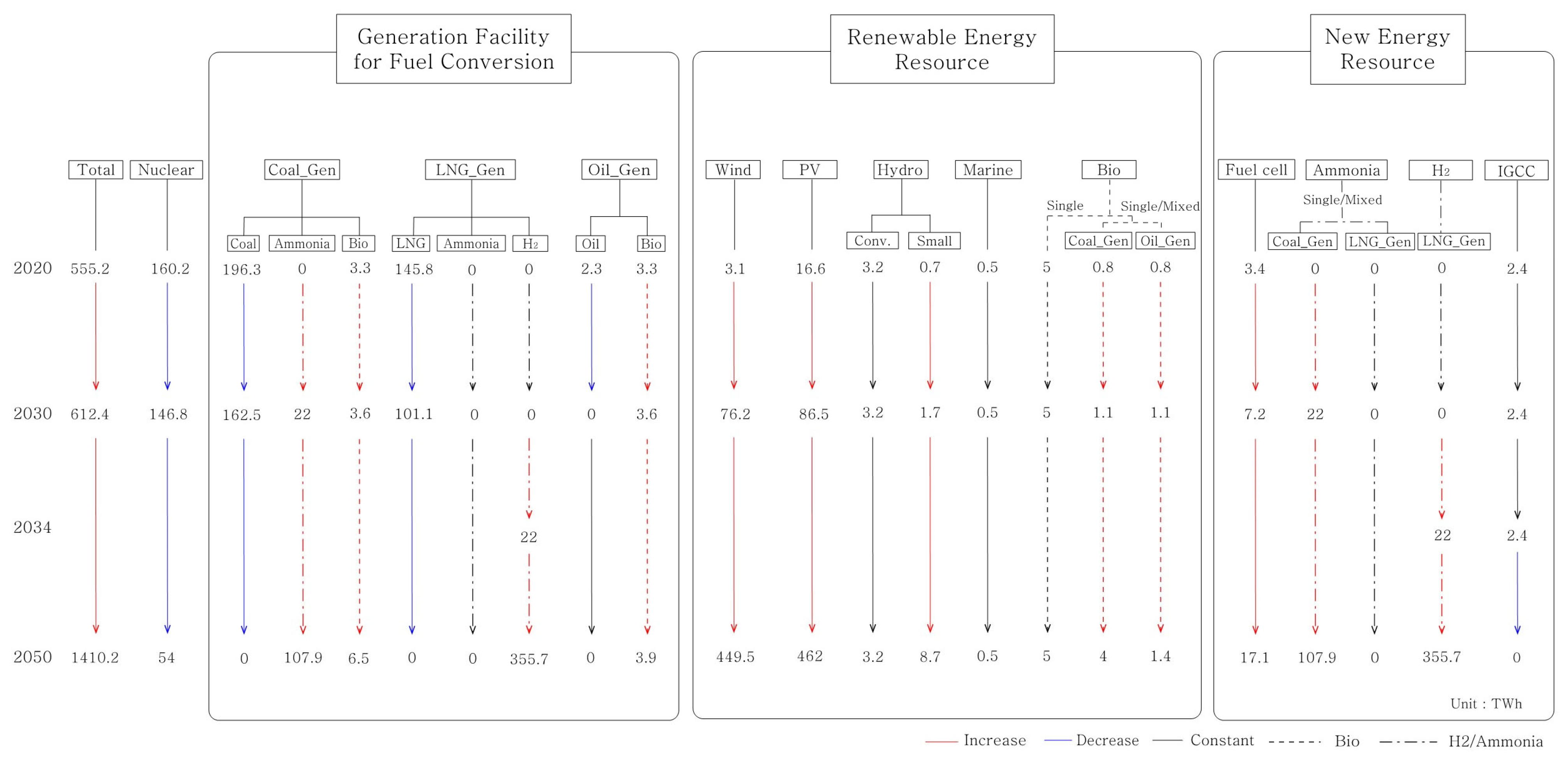
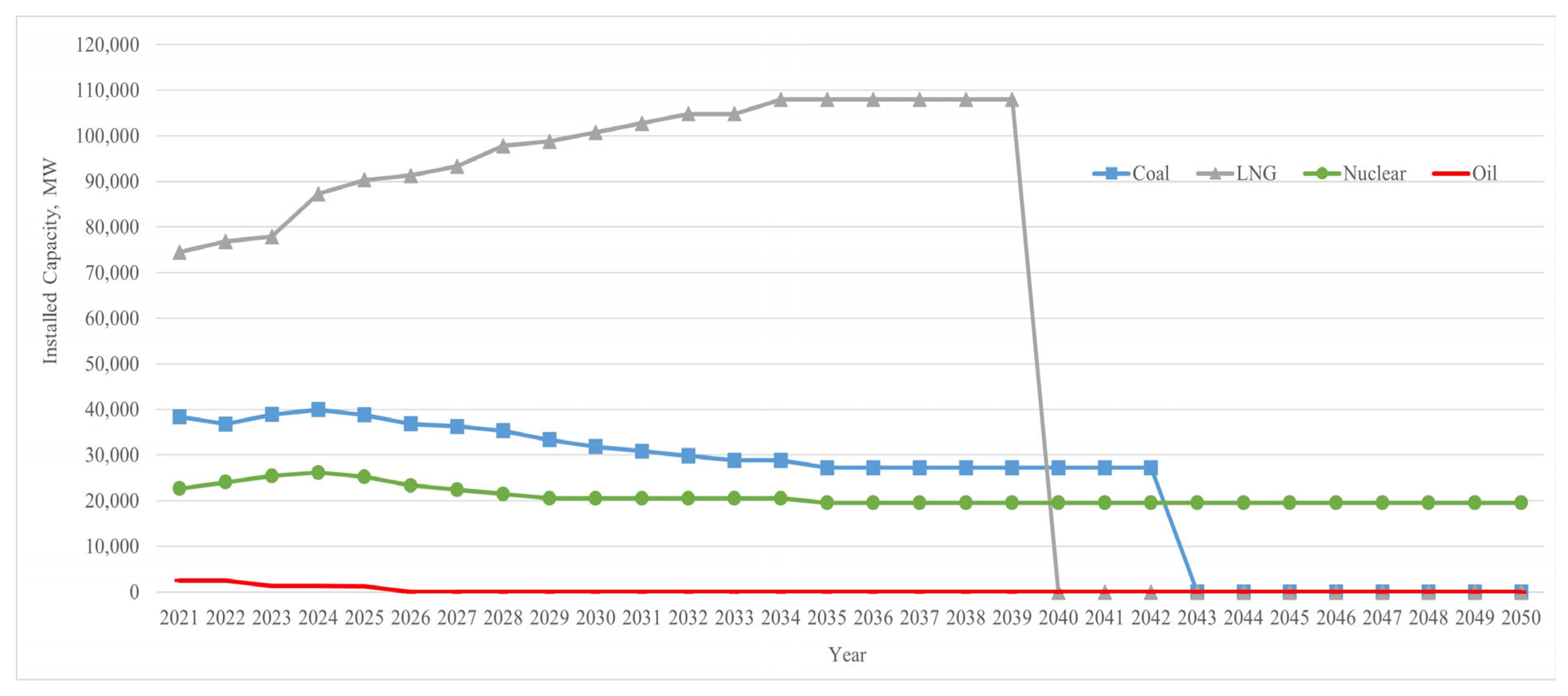
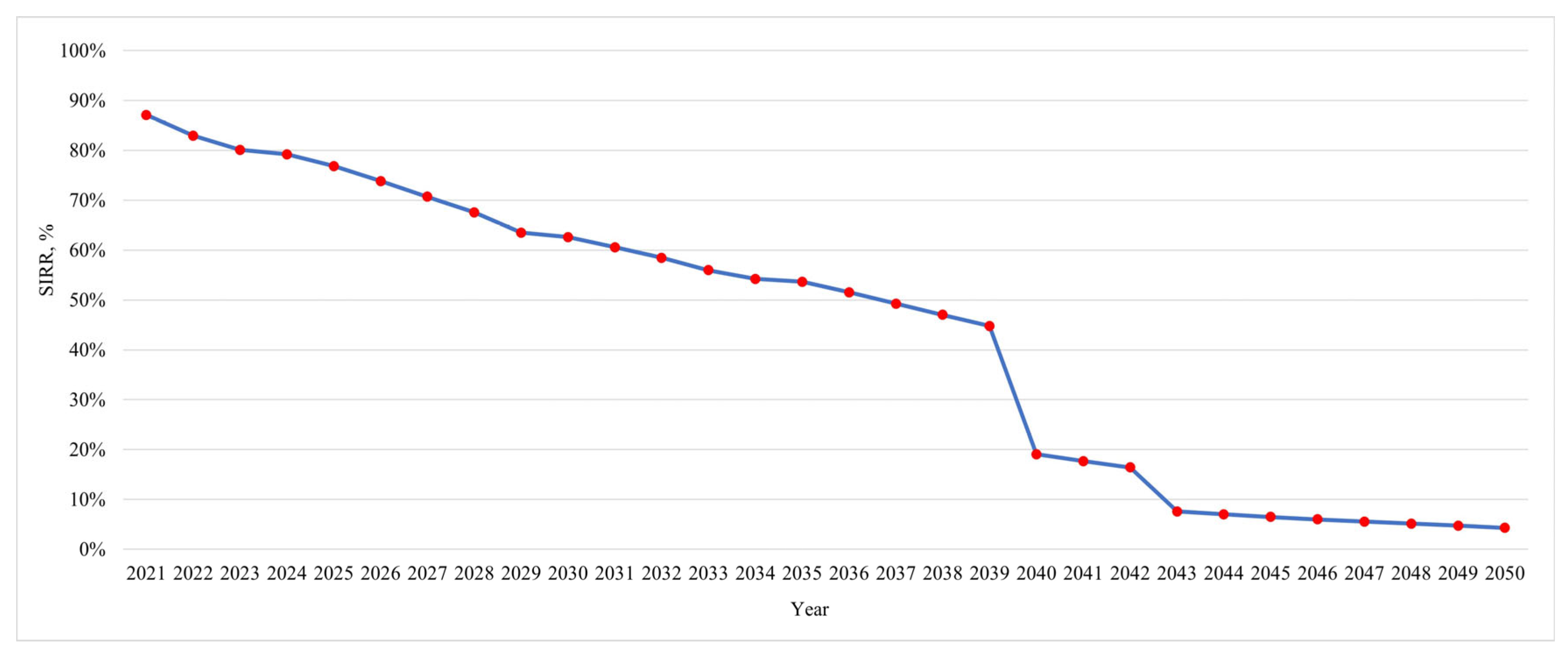
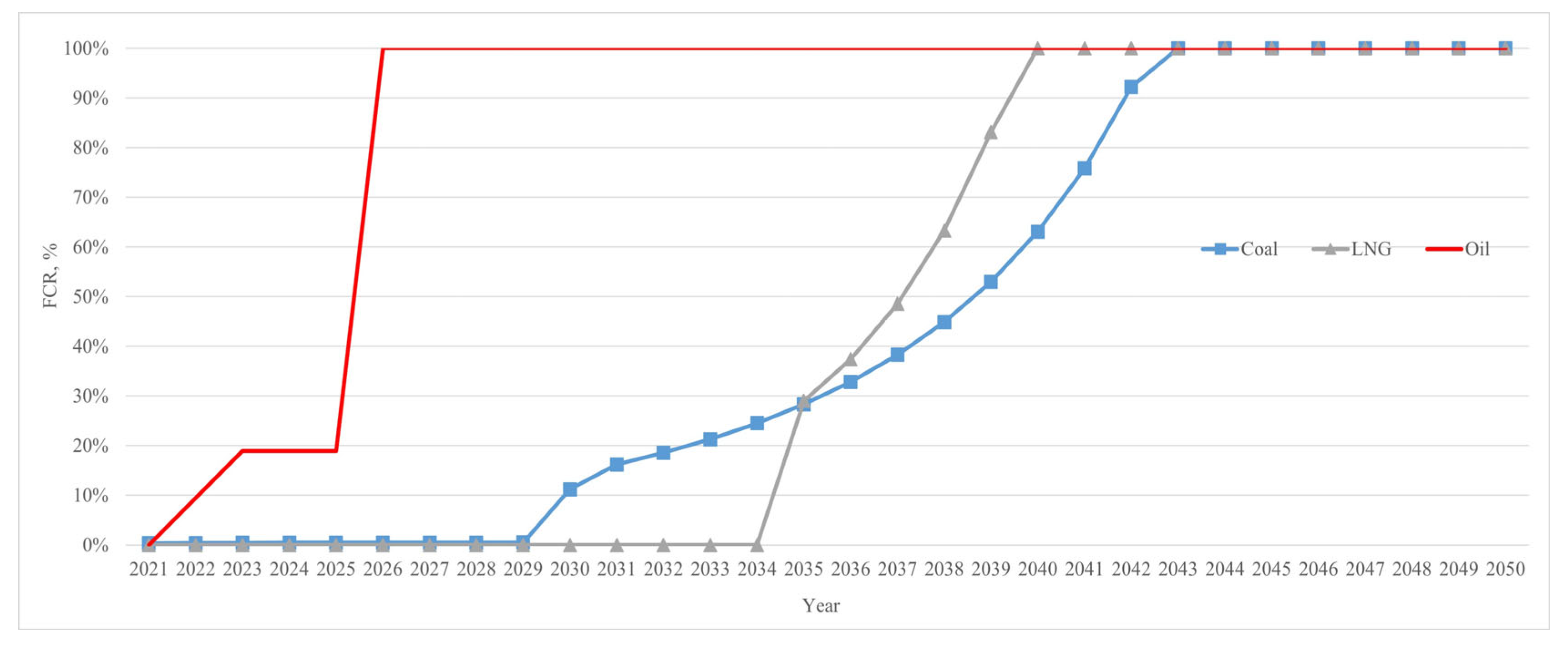
| Category | SCA | Non-SCA | Jeju |
|---|---|---|---|
| Wind | 1.85% | 79.79% | 18.36% |
| PV | 6.93% | 90.58% | 2.49% |
| Conventional hydro | 17.77% | 82.23% | 0% |
| Small hydro | 17.77% | 81.76% | 0.47% |
| Marine energy | 99.97% | 0.03% | 0% |
| Bioenergy (mixed combustion) | 11.04% | 61.40% | 27.57% |
| Fuel cells | 75.38% | 24.62% | 0% |
| IGCC | 0% | 100% | 0% |
| Ammonia | 37.37% | 62.35% | 0.27% |
| Hydrogen | 65.11% | 34.25% | 0.64% |
| Resource Name | Commissioning Date | Decommissioning Date | Capacity (MW) |
|---|---|---|---|
| Ulsan #4 | 1 February 1977 | 10 February 2022 | 400 |
| Ulsan #5 | 1 February 1977 | 10 February 2022 | 400 |
| Ulsan #6 | 1 February 1977 | 10 February 2022 | 400 |
| Daesan 1CC | 1 May 1998 | 1 January 2100 | 466 |
| Daejeon CHP | 1 May 2002 | 1 June 2026 | 88 |
| Cheongju CHP #1 | 1 August 2002 | 1 December 2024 | 61 |
| Daegu CHP #1 | 1 October 2002 | 1 December 2024 | 44 |
| Suwon CHP #1 | 1 October 2002 | 31 December 2026 | 43 |
| Jeju IC #1 | 1 June 2005 | 31 December 2050 | 40 |
| Jeju IC #2 | 1 June 2009 | 31 December 2050 | 40 |
| Moorim Powertech CHP | 1 August 2018 | 31 December 2050 | 26 |
| Total capacity (as of December 2020) | 2008 MW | ||
Disclaimer/Publisher’s Note: The statements, opinions and data contained in all publications are solely those of the individual author(s) and contributor(s) and not of MDPI and/or the editor(s). MDPI and/or the editor(s) disclaim responsibility for any injury to people or property resulting from any ideas, methods, instructions or products referred to in the content. |
© 2024 by the authors. Licensee MDPI, Basel, Switzerland. This article is an open access article distributed under the terms and conditions of the Creative Commons Attribution (CC BY) license (https://creativecommons.org/licenses/by/4.0/).
Share and Cite
Min, C.; Kim, H. A Practical Framework for Developing Net-Zero Electricity Mix Scenarios: A Case Study of South Korea. Energies 2024, 17, 926. https://doi.org/10.3390/en17040926
Min C, Kim H. A Practical Framework for Developing Net-Zero Electricity Mix Scenarios: A Case Study of South Korea. Energies. 2024; 17(4):926. https://doi.org/10.3390/en17040926
Chicago/Turabian StyleMin, Changgi, and Heejin Kim. 2024. "A Practical Framework for Developing Net-Zero Electricity Mix Scenarios: A Case Study of South Korea" Energies 17, no. 4: 926. https://doi.org/10.3390/en17040926
APA StyleMin, C., & Kim, H. (2024). A Practical Framework for Developing Net-Zero Electricity Mix Scenarios: A Case Study of South Korea. Energies, 17(4), 926. https://doi.org/10.3390/en17040926







